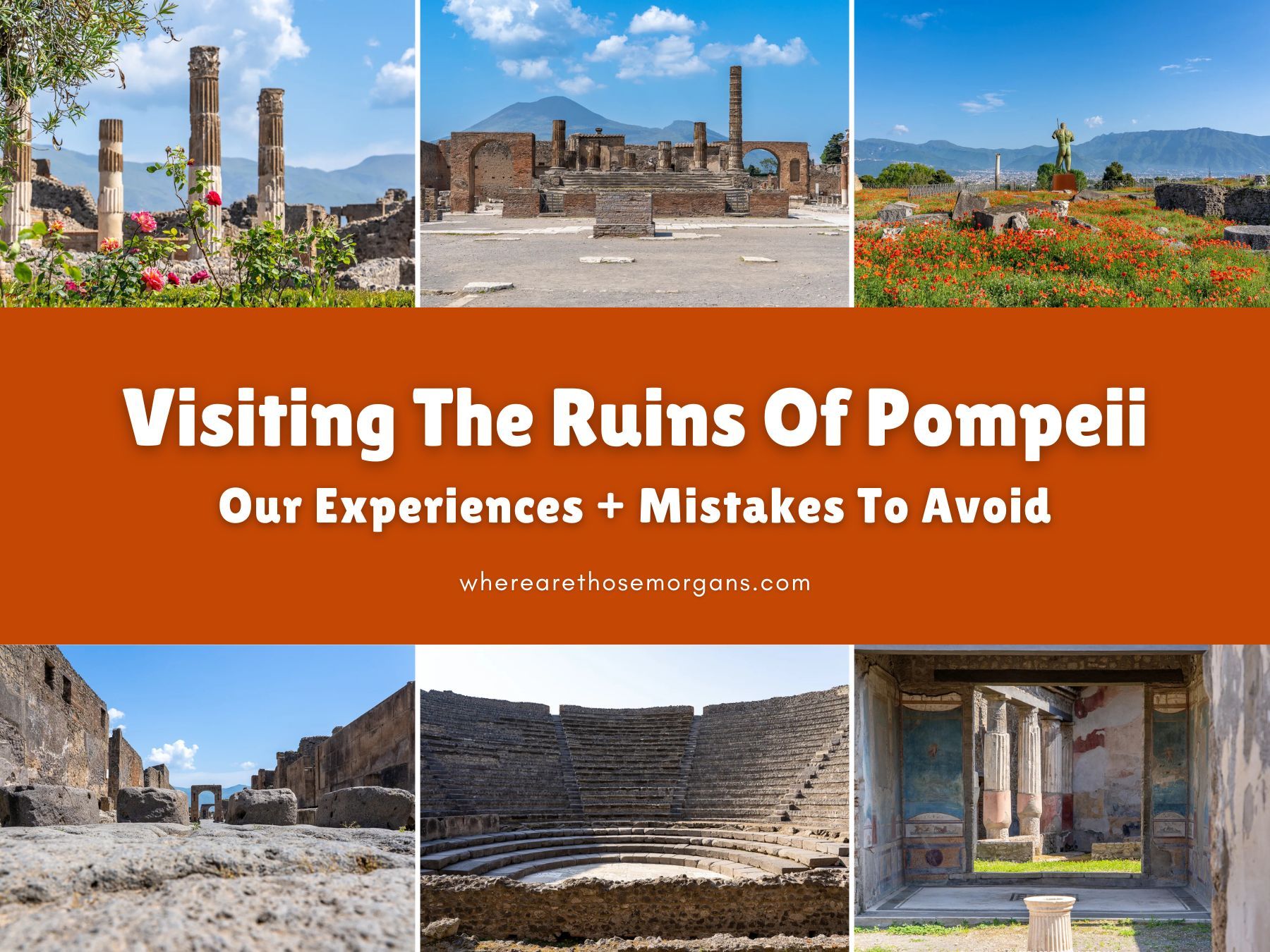
After ticking off almost everything there is to see and do across two trips to the Gulf of Naples and Amalfi Coast, we think Pompeii is one of the region’s few truly unmissable places to experience. Herculaneum was great, but the scale of Pompeii was just immense. And climbing to the cone of Vesuvius was cool but it was a pain to reach, whereas Pompeii was super easy to visit.
Honestly, we half expected the ruins of Pompeii to be a tacky commercialized tourist conveyor belt. But it was the complete opposite. Yes, it can be busy, but overall we think they’ve done a superb job of keeping it authentic, immersive and meaningful. We’ve already explored the ruins twice, and we’d happily go back again.
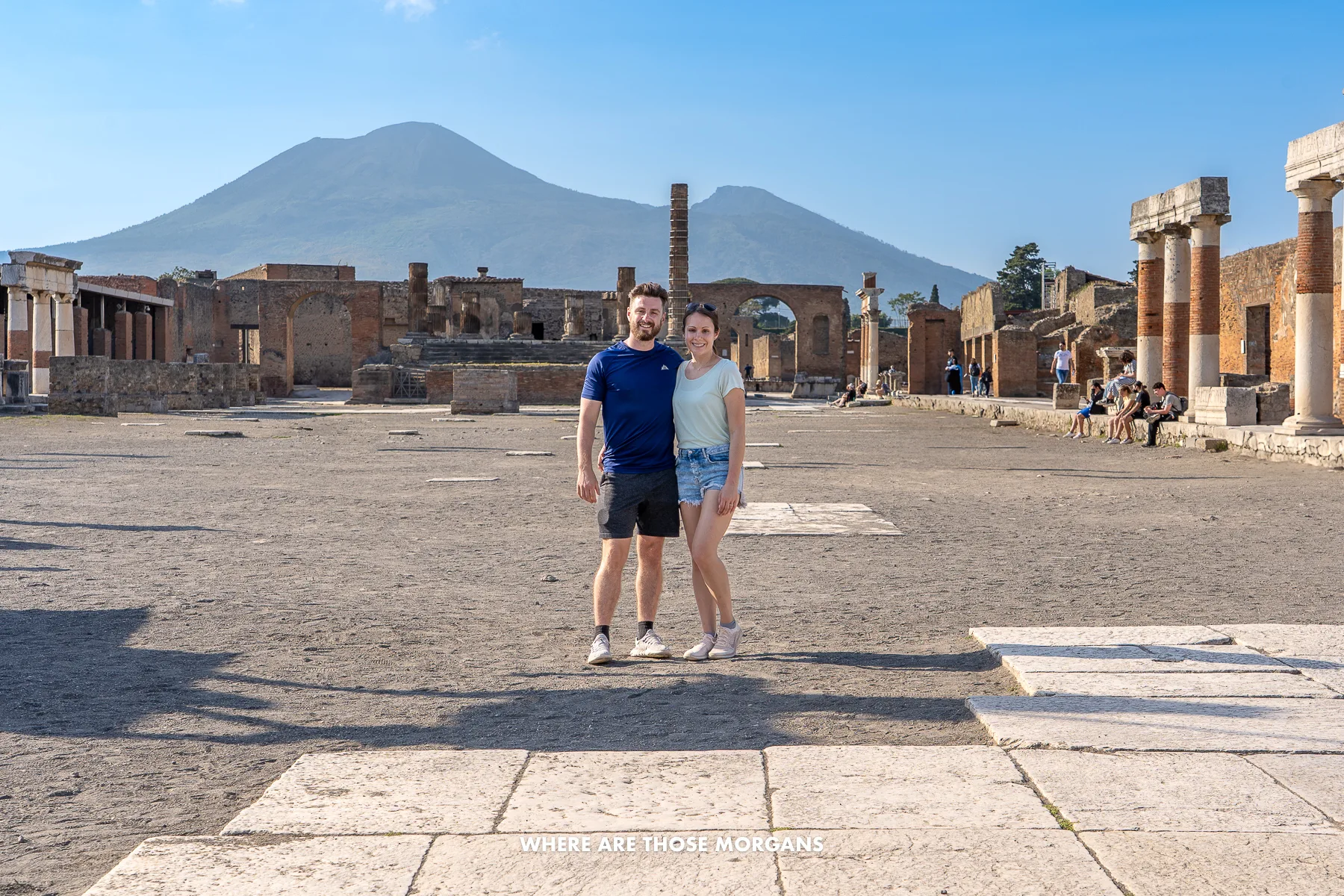 Here we are in the Forum of Pompeii
Here we are in the Forum of Pompeii
Hi, we’re Mark and Kristen Morgan. We left our scientific careers in 2018 to become travel writers and photographers, and since then our expert guides have helped millions of travel planners take better trips. Read more about us.
Why trust us with your Pompeii plans? After walking around Pompeii’s ruins twice, we share our genuine experiences to help you decide the best way to visit when you’re in Italy. As always, every photo in this guide is ours.
August 24th, 79 AD. That was the fateful day when Vesuvius devastated the thriving Roman cities of Pompeii and nearby Herculaneum. It was impossible not to feel sad as we walked around the ruins, but alongside the eerie and somber mood we couldn’t help being left in awe at the sheer power of nature.
In this guide we explain our two Pompeii experiences, we simplify the complicated ticket options to help you get inside, we walk you through the common mistakes to avoid based on what we learned, and we give you the best walking route map to follow. Okay, let’s begin!
Note: Our content is reader supported and contains affiliate links. If you make a purchase through one of these links, we may earn a small commission at no extra cost to you and it helps us keep this site running.
Our Two Pompeii Experiences
To begin, we’re going to walk you through how we visited Pompeii in 2018 and 2022. Take note of the transport we took, what we did before entering the ruins and the mistakes we made.
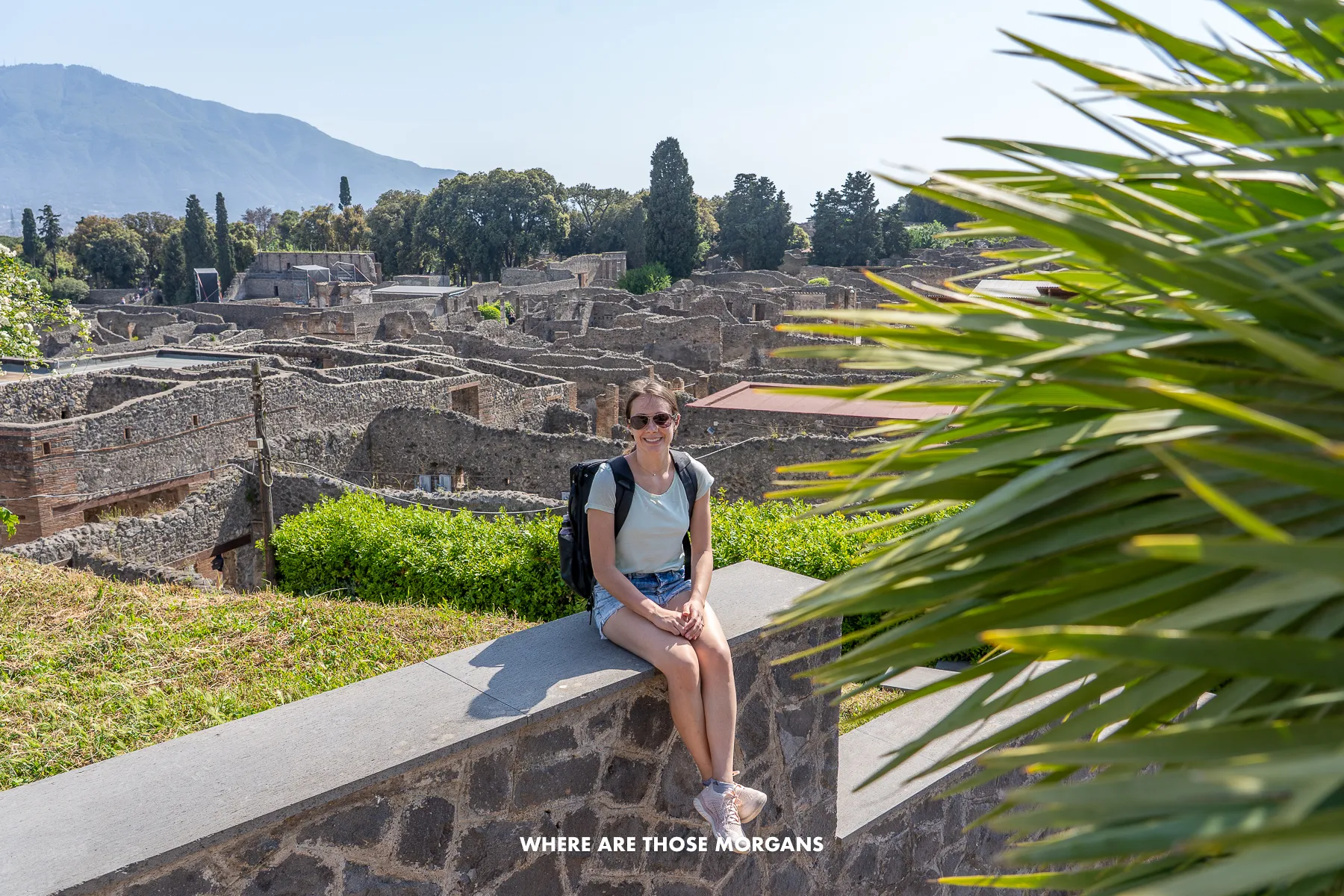 Here’s Kristen taking a quick break from all the walking
Here’s Kristen taking a quick break from all the walking
July 2018
Our first time visiting Pompeii was on a scorching hot afternoon in July 2018. We stayed in Naples for a few nights as part of a 2-week trip through Italy, and seeing the famous ruins was top of our bucket list for the area.
After crushing a few incredible Neapolitan pizzas and seeing the most important original artifacts from Pompeii inside the National Archaeological Museum of Naples, here’s how we did Vesuvius and Pompeii in the same day from Naples:
- Circumvesuviana train to Ercolano (red line)
- Vesuvio Express bus to Vesuvius
- Climbed up to the summit
- Bus back to Ercolano
- Another Circumvesuviana train to Pompei Scavi (red line)
- Explored Pompeii ruins
- Final Circumvesuviana train back to Naples (red line)
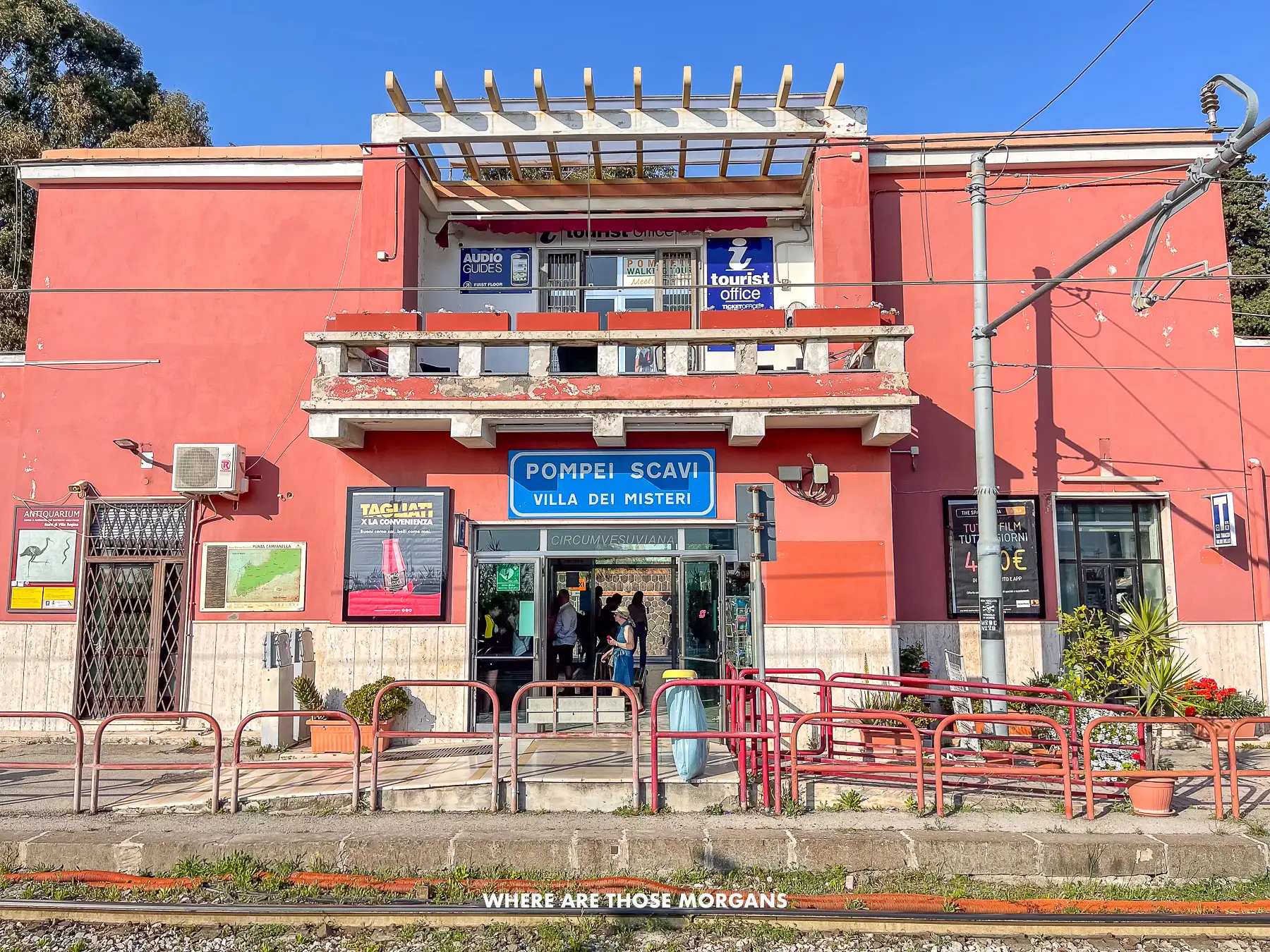 This is the small train station at the entrance to the ruins with links to Naples and Sorrento
This is the small train station at the entrance to the ruins with links to Naples and Sorrento
We saw on our maps app that Pompei Scavi train station was right next to the main entrance to the ruins (Porta Marina) and there were a few places to eat just before going inside.
And we’d pre-booked Pompeii “Express” tickets in advance online, so we didn’t have to worry about waiting in a line to buy tickets on the day.
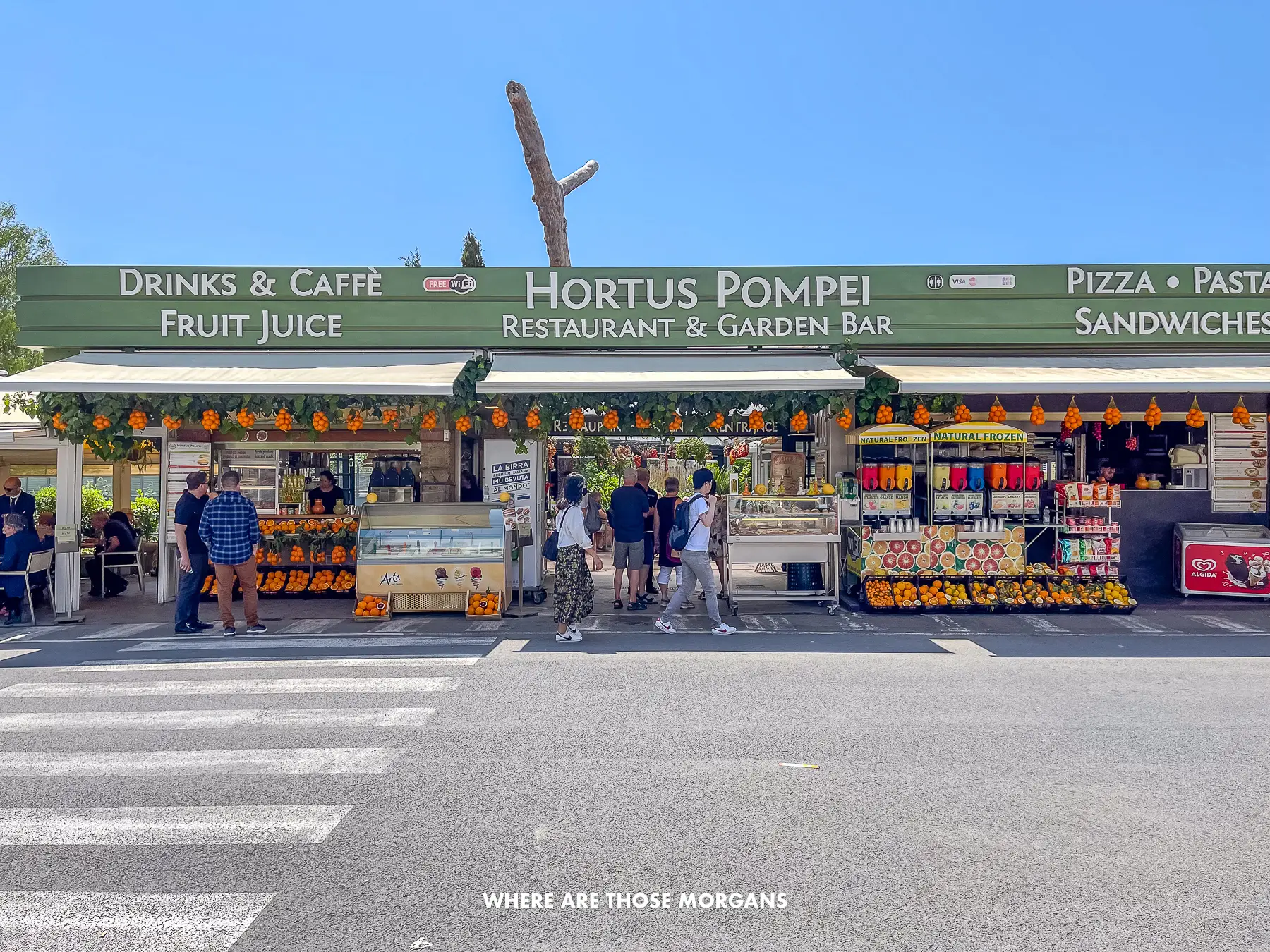 This was one of the not-so-great restaurants outside the entrance
This was one of the not-so-great restaurants outside the entrance
Annoyingly, all the restaurants outside the entrance turned out to be tourist traps with average food at best. But it was lunch time and we’d already hiked up to Vesuvius on a boiling hot day so we needed sustenance.
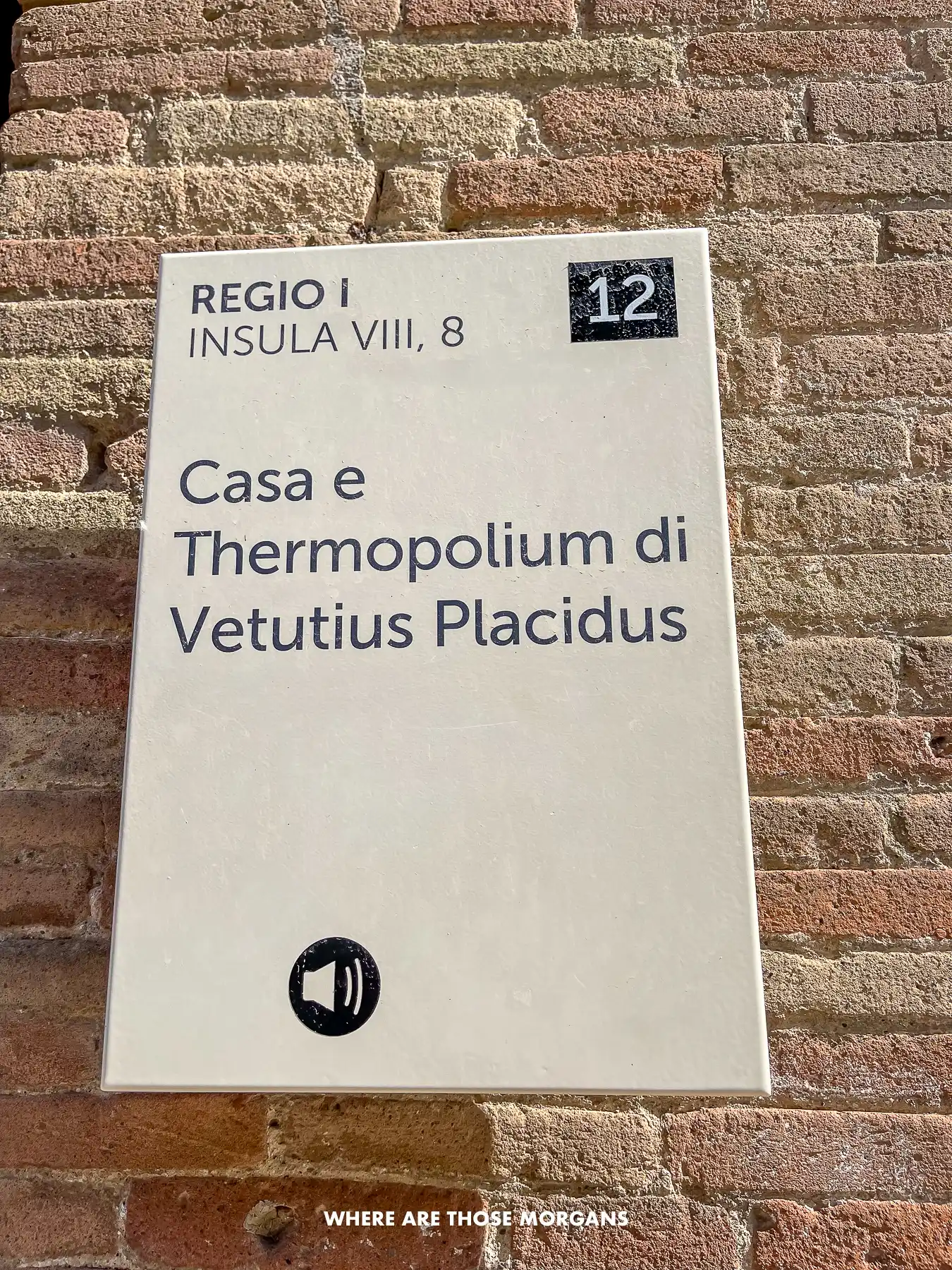 This was one of the site names with corresponding audio guide numbers
This was one of the site names with corresponding audio guide numbers
After overpaying for subpar food, we entered the ruins and paid to rent audio guides to use throughout the site. Then we spent a good 4 hours exploring the ruins from top to bottom and side to side. And it was genuinely an amazing experience.
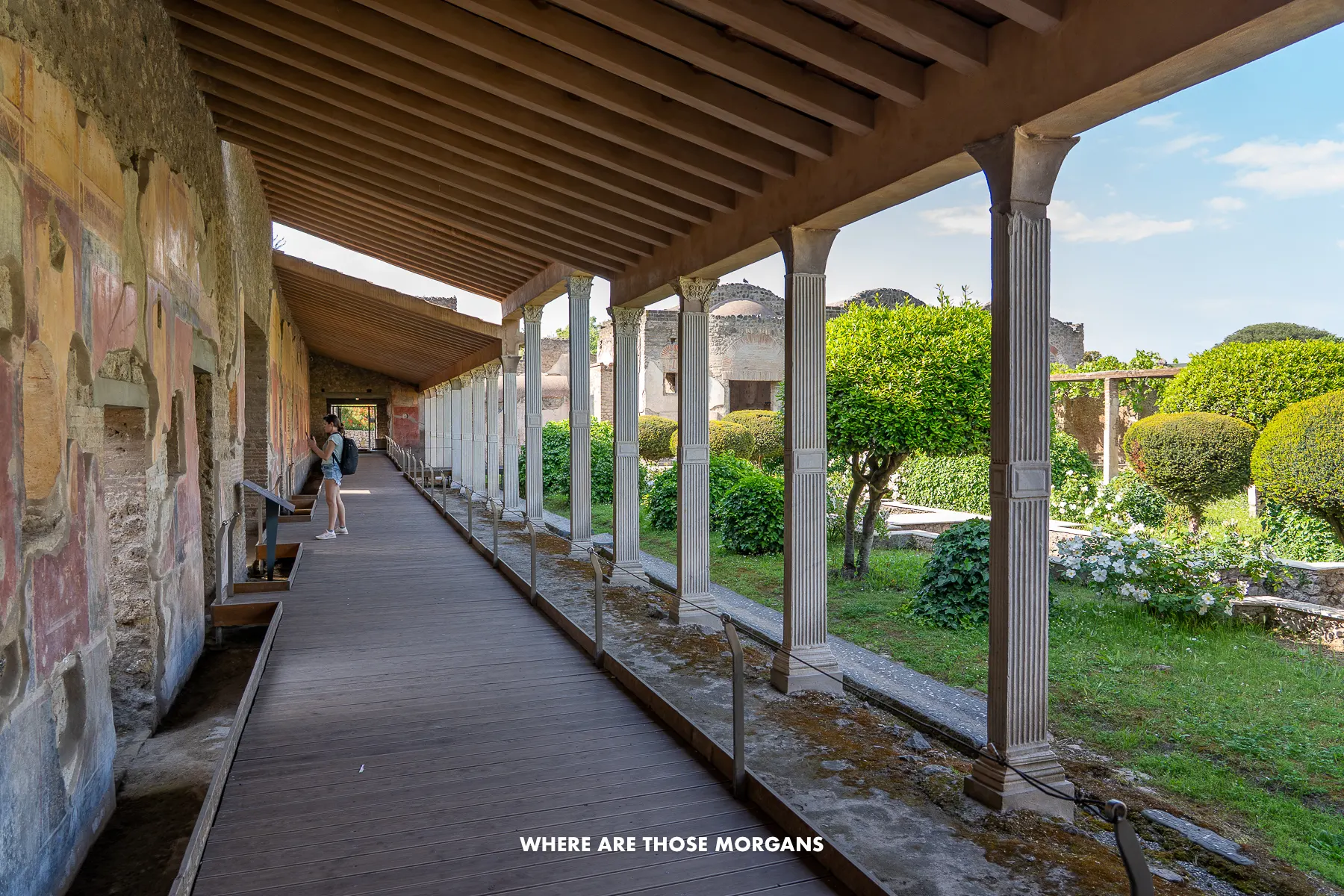 This was Kristen looking at the frescoes in Casa degli Archi
This was Kristen looking at the frescoes in Casa degli Archi
We grabbed a map at the entrance and formulated a rough walking route, then synced up the numbered plaques with our audio guides to learn more about each point of interest. For a self-guided audio tour (which can be dreadful at times), it was actually pretty comprehensive.
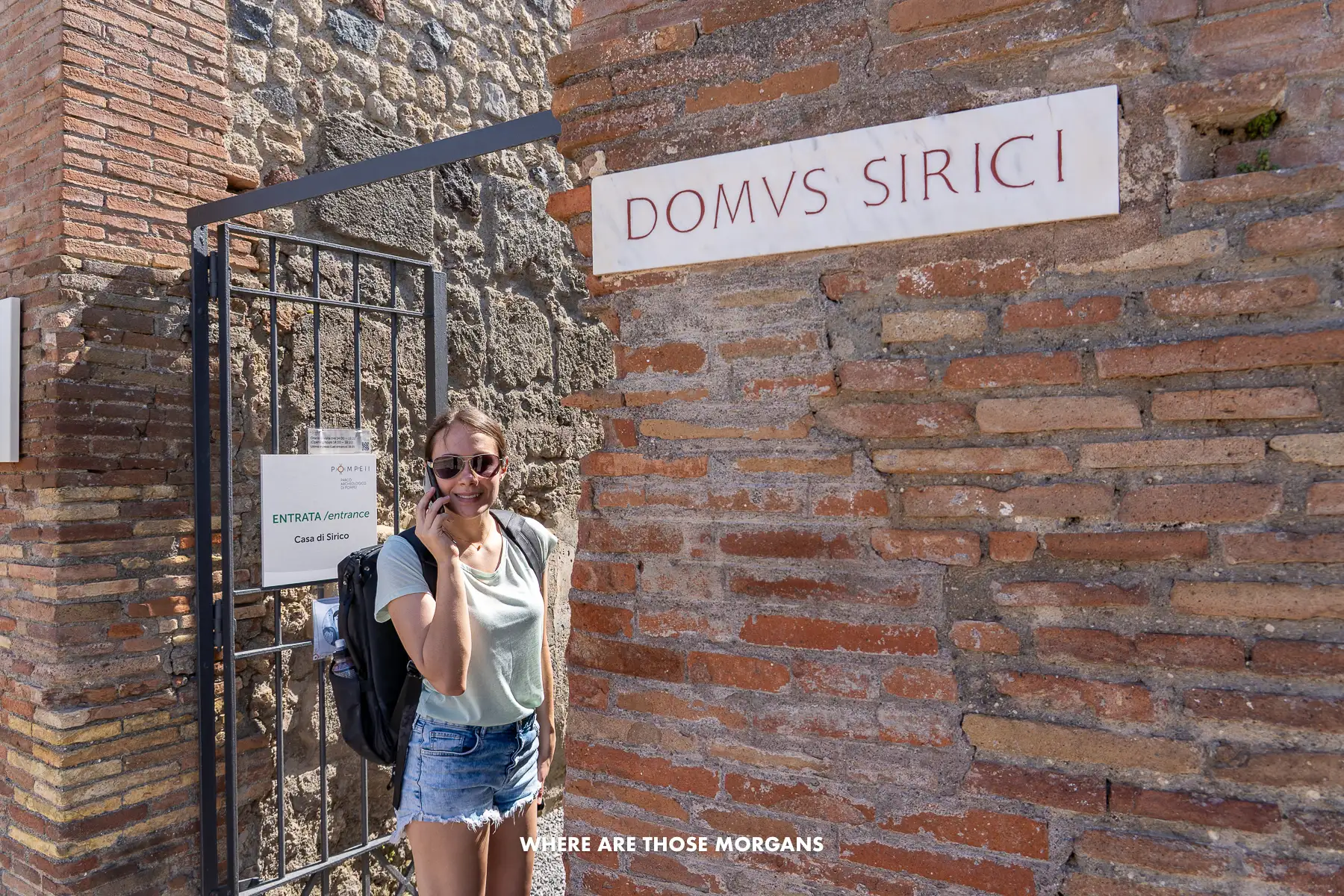 Here’s Kristen listening to the audio guide at Casa di Sirico
Here’s Kristen listening to the audio guide at Casa di Sirico
That said, we have to admit we found ourselves switching off and losing interest a little bit at times. The ruins were so vast and exposed – which led to us being tired and torched by the sun – and listening to our audio guides for several hours as we tried to figure out a route became tedious.
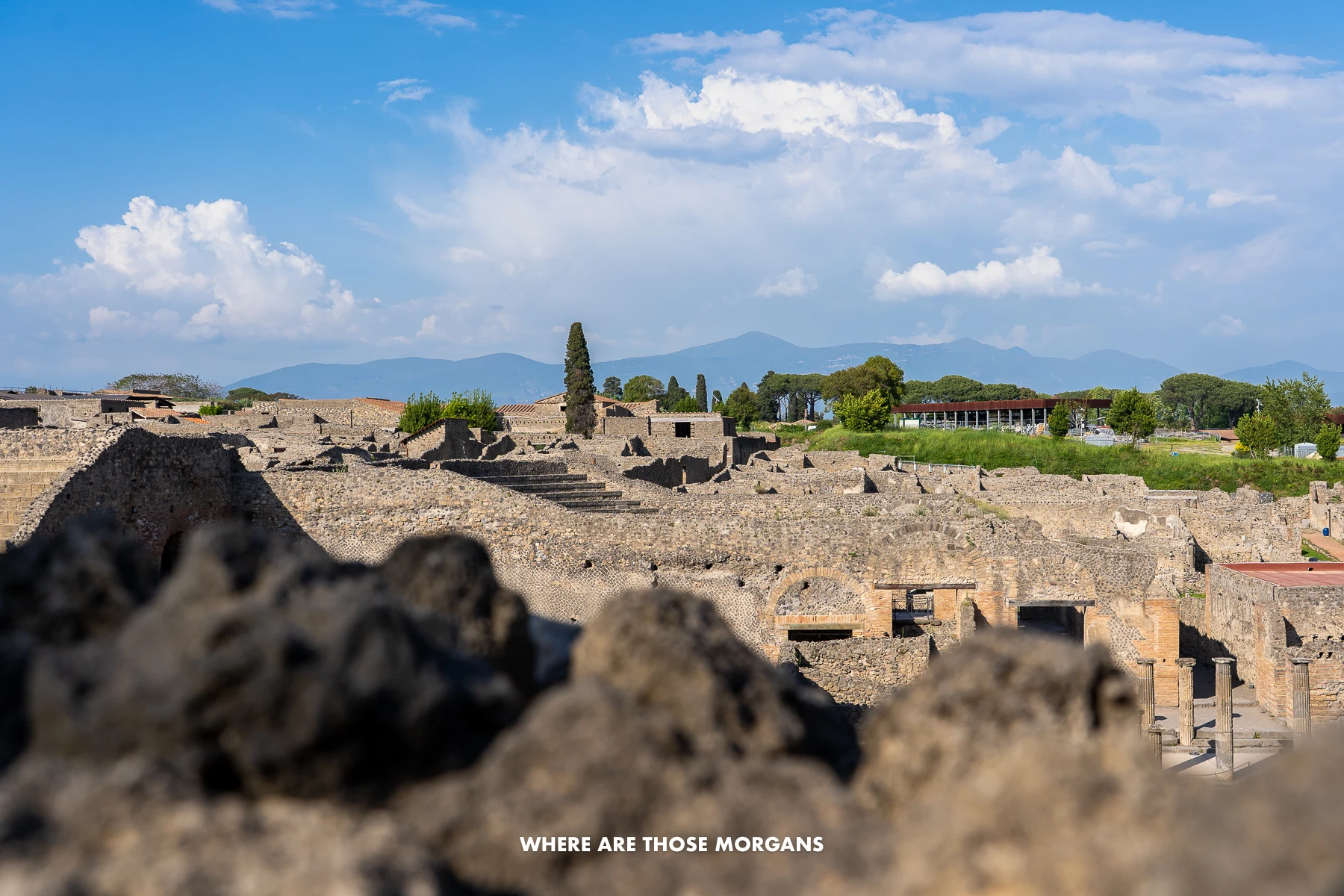 We took this photo near the Theater District
We took this photo near the Theater District
Our favorite spots inside the ruins included the Foro di Pompei with Vesuvius views, Casa del Fauno, Casa dei Vettii, Lupanare di Pompei, Amphitheater of Pompeii, the Orto dei Fuggiaschi (Garden of the Fugitives) – incredibly sad but important to see, and finally Teatro Piccolo, which we thought was far more photogenic than Teatro Grande.
May 2022
The second time we visited Pompeii was in May 2022. This time we did 3 weeks in Italy and we started our trip by spending 12 days exploring the Gulf of Naples and Amalfi Coast.
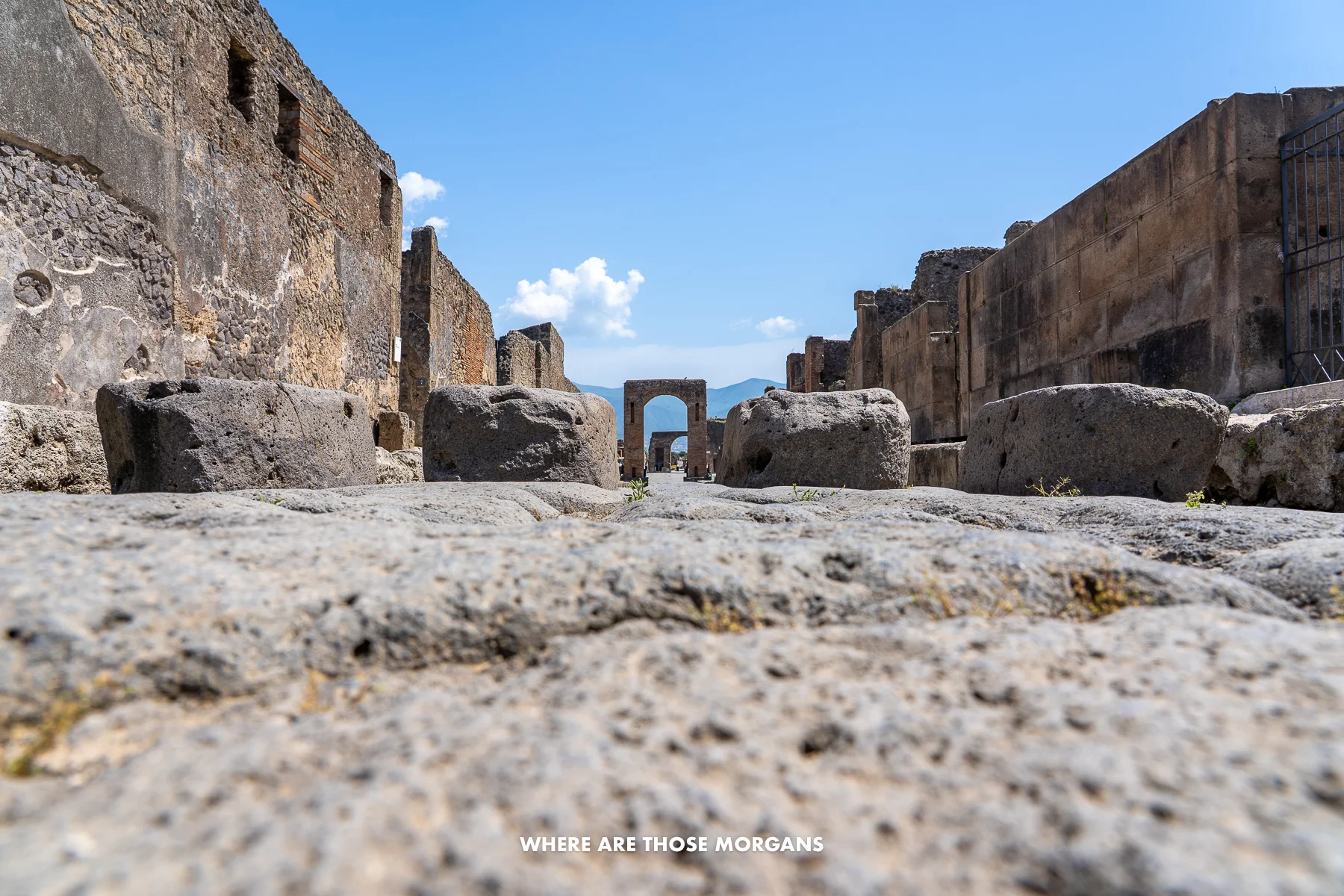 These stepping stones were used as a pedestrian crosswalk to avoid water and mud
These stepping stones were used as a pedestrian crosswalk to avoid water and mud
Instead of staying in Naples, we took a ride share straight from the airport to the small town of Ercolano and checked into our hotel after dark.
First thing the next morning we took the same Vesuvio Express bus from Ercolano to Vesuvius for our second ascent of the volcano. Honestly, it reaffirmed our conclusion from the first time that Vesuvius is fun to see, but we don’t think it’s essential for a first visit to the region.
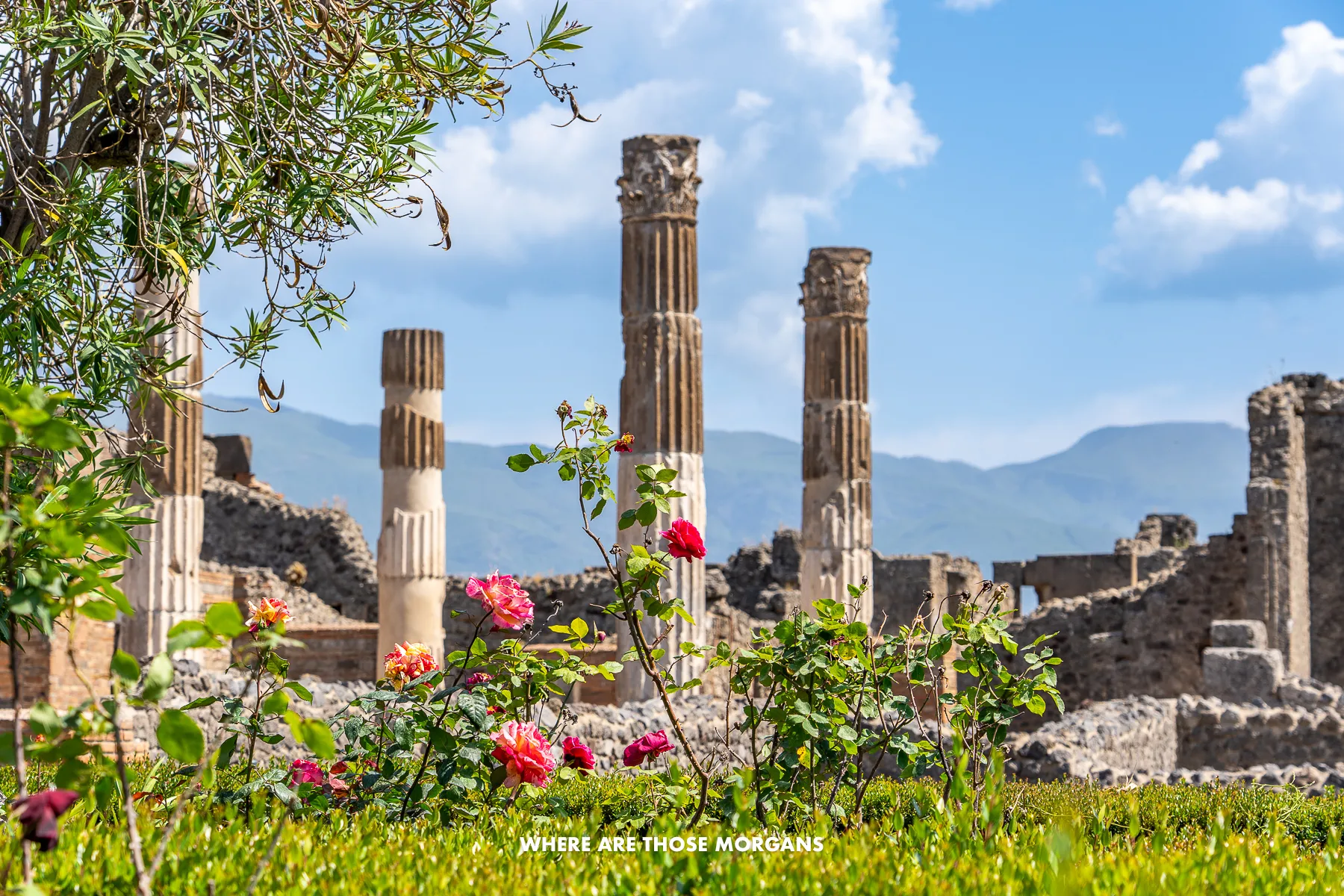 We loved the bright flowers contrasting against the ruins
We loved the bright flowers contrasting against the ruins
After getting off the bus back in Ercolano, we took the other Circumvesuviana train to Pompei Santuario (green line) so we could walk through the modern town rather than just visit the ruins, and so we could grab lunch from a better place than the tourist traps outside the entrance.
And guess what? The new town of Pompei was lovely, clean, upscale and had a ton of great restaurants. We highly recommend allowing extra time to see it before or after the ruins.
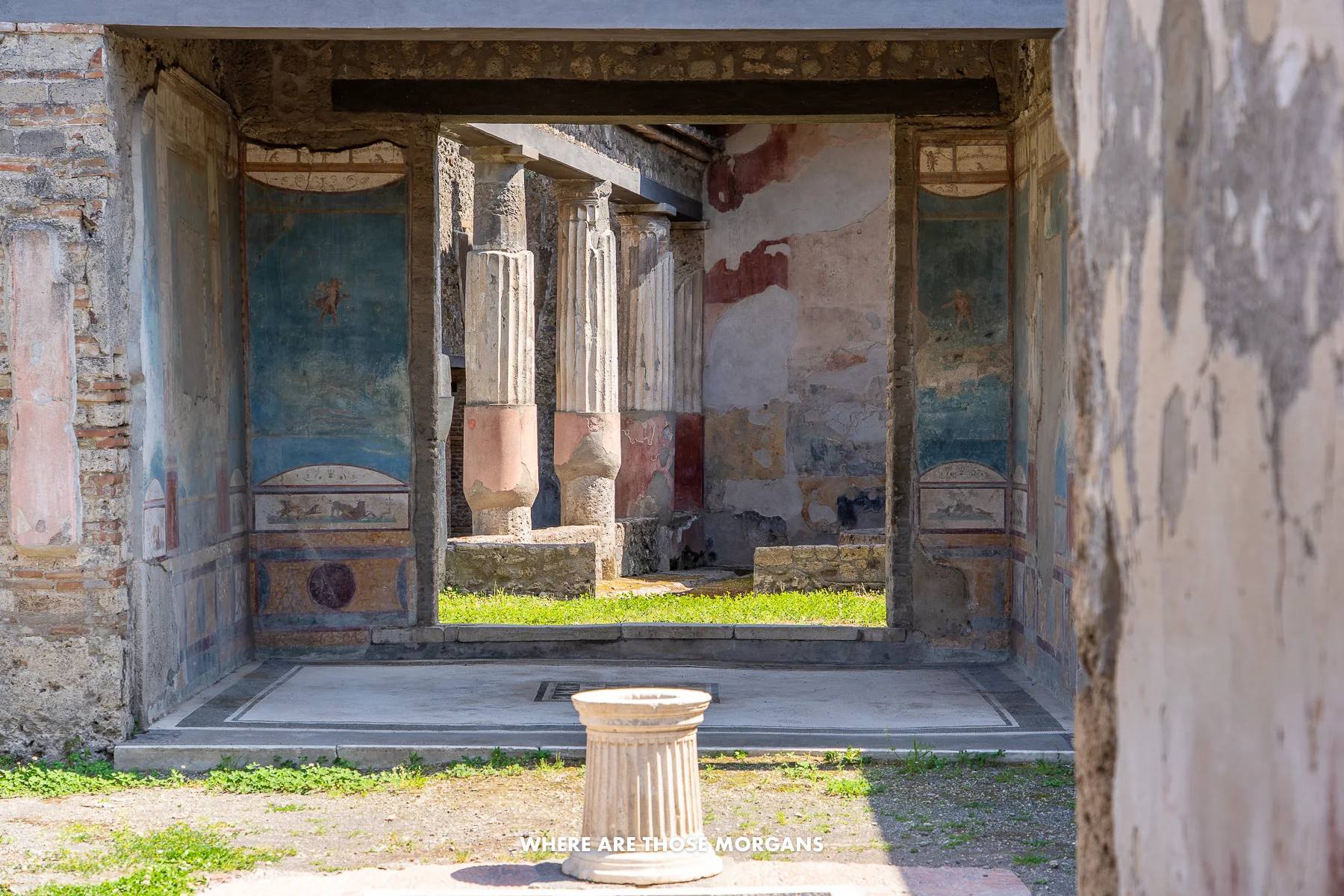 This was one of our favorite ruined houses with frescoes largely in-tact
This was one of our favorite ruined houses with frescoes largely in-tact
Another reason we did it this way around was so we could explore Herculaneum ruins the following morning, before checking out of our hotel and taking a Circumvesuviana train from Ercolano to Sorrento with our suitcases. The logistics here can be a nightmare!
We ate a delicious lunch at Na’ Pasta, enjoyed a slow walk through the new town and eventually arrived at the main entrance to Pompeii (Porta Marina). We’d pre-booked tickets again, but this time we paid a bit more to get the “Plus” tickets, which meant we could access a few additional villas.
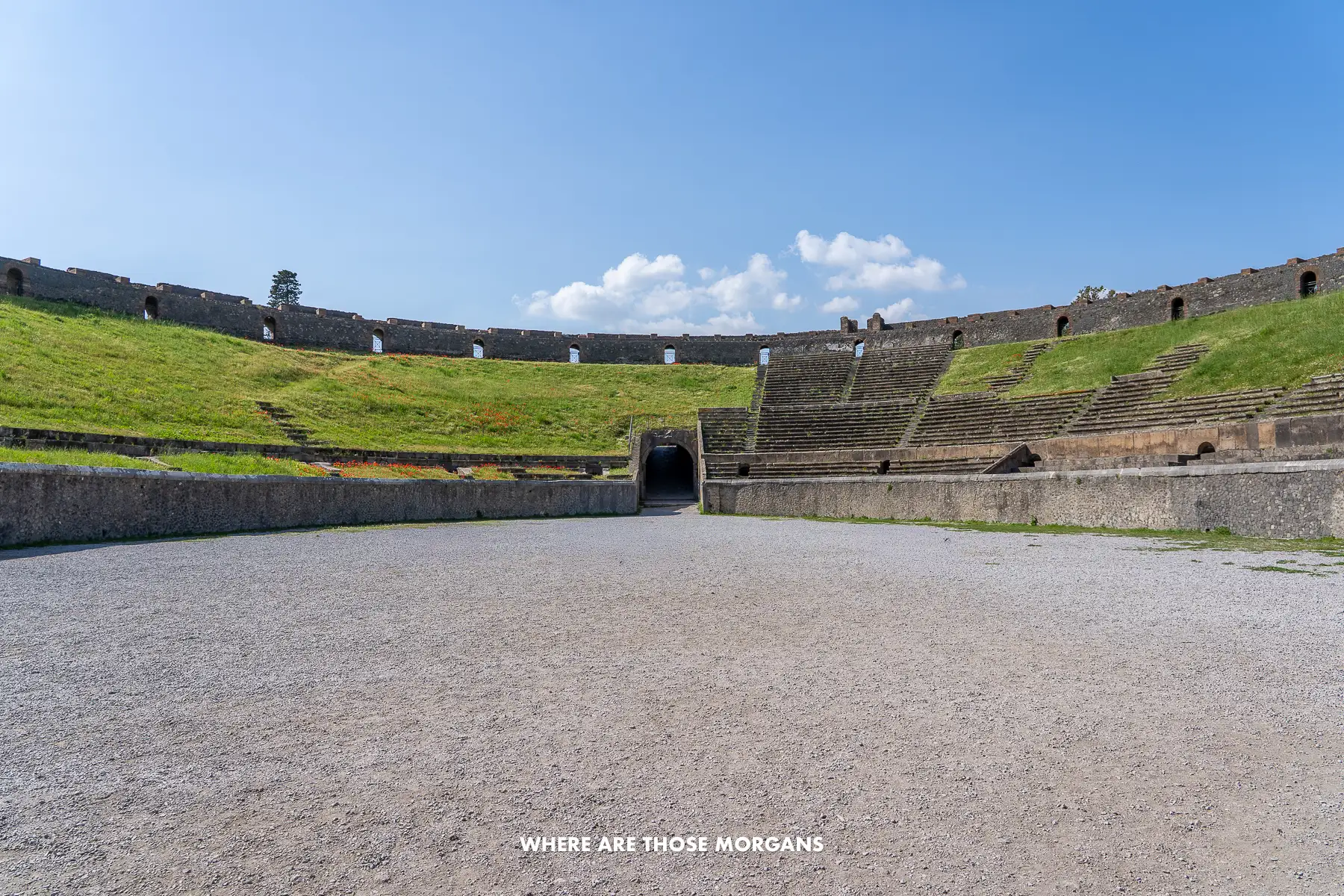 We had the inside of the amphitheater to ourselves for a few minutes
We had the inside of the amphitheater to ourselves for a few minutes
Then just like the first time we visited, we spent about 4 hours exploring the ruins far and wide. We had better cameras, lenses and photography skills the second time, so we really focused our visit on capturing the ruins through imagery and it was fun to experience Pompeii in a different way.
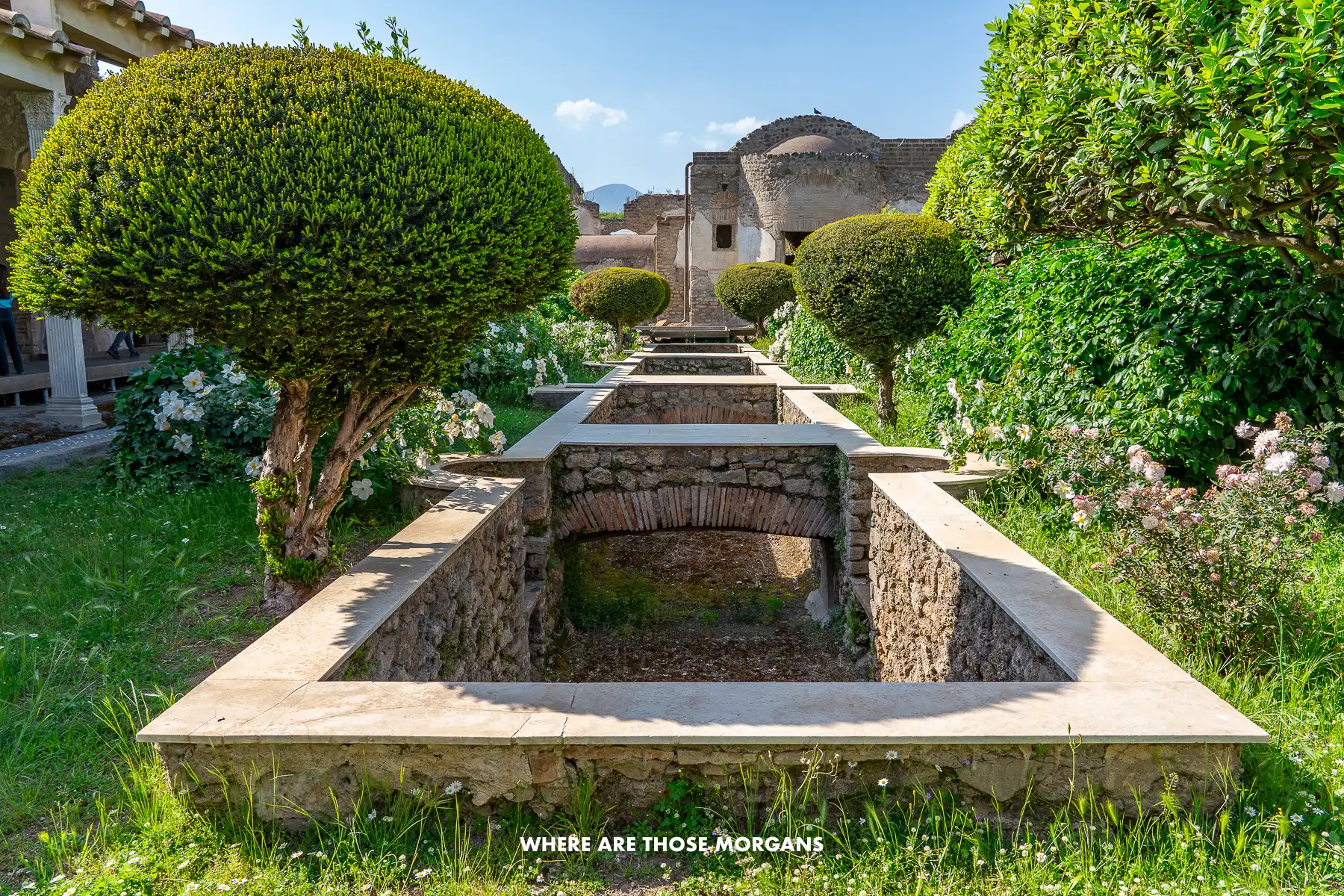 This is one of our favorite photos from the ruins at Casa degli Archi
This is one of our favorite photos from the ruins at Casa degli Archi
The weather in mid-May was much cooler and we were able to cover more ground, and we had the “Plus” tickets so this time we also visited more places including Villa dei Misteri, Villa di Diomede, Casa degli Archi, Casa del Menandro and the Necropoli di Porta Nocera.
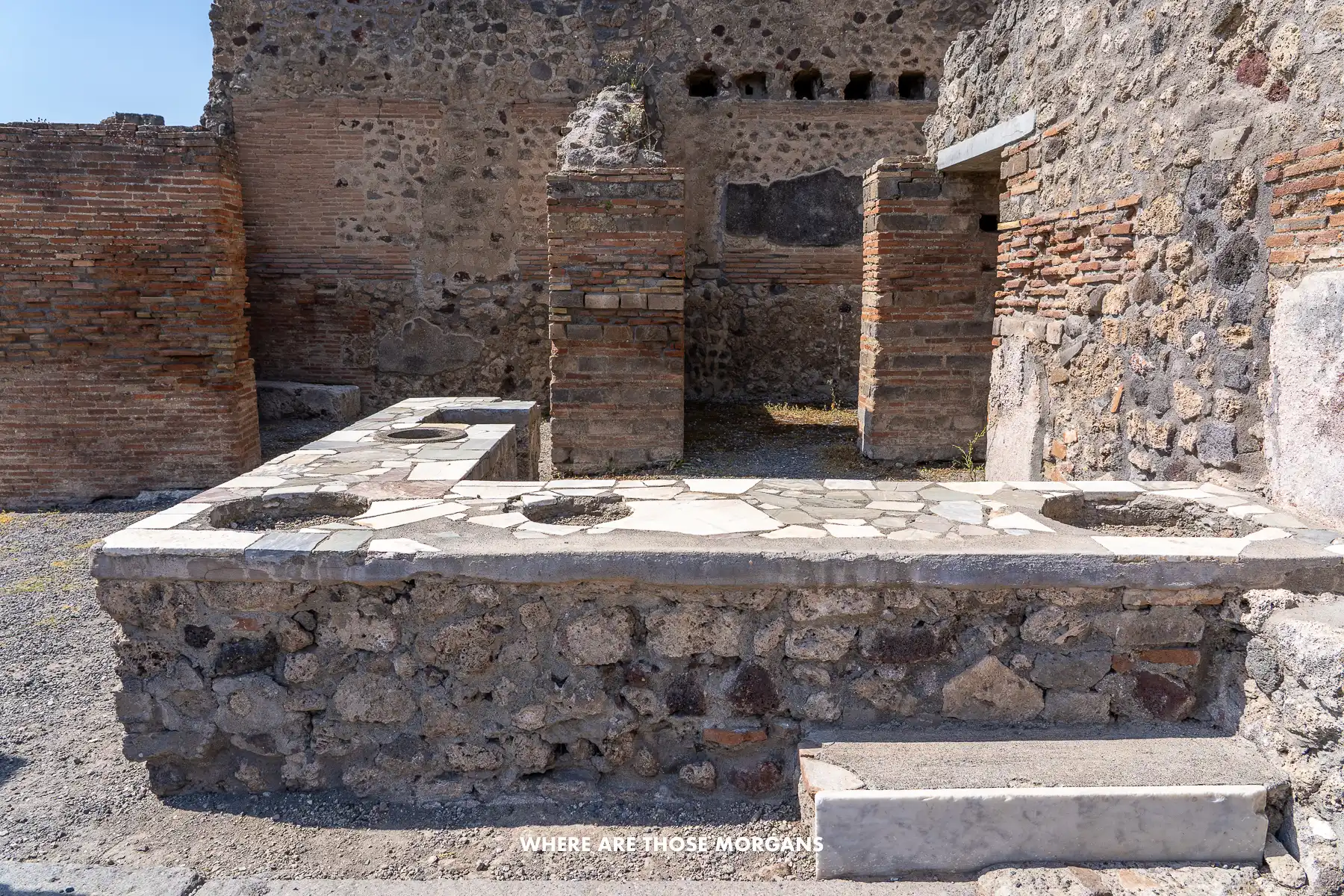 This is what remains from one of the ancient food markets in town
This is what remains from one of the ancient food markets in town
We didn’t go inside the Antiquarium first time around because we visited the much bigger and more important museum in Naples. But the second time we did stop into the small archaeological museum on the way out of Pompeii and it was worth seeing.
Tickets + Hours
Okay, we’re going to be blunt – pre-booking advanced entry tickets for Pompeii is frustratingly difficult. Just like a lot of other popular attractions in Italy, they could make it so much easier and more user friendly, but for whatever reason they just won’t improve the process.
We’re going to make it as straightforward as we can to help you get through the booking process. First, you do not buy tickets through the official Pompeii website (pompeiisites.org), you buy them through the official ticketing partner called TicketOne.
Follow these steps to book entry tickets for Pompeii on the TicketOne website:
- Head over to the TicketOne site
- Select Parco Archeologico di Pompei
- Choose your date and entry time (morning or afternoon)
- Select the number of “Express” or “Plus” tickets you want to book
- Optionally add ticket insurance (you won’t be able to get a refund without insurance)
- Create an account with TicketOne (annoying but compulsory)
- Pay for your tickets
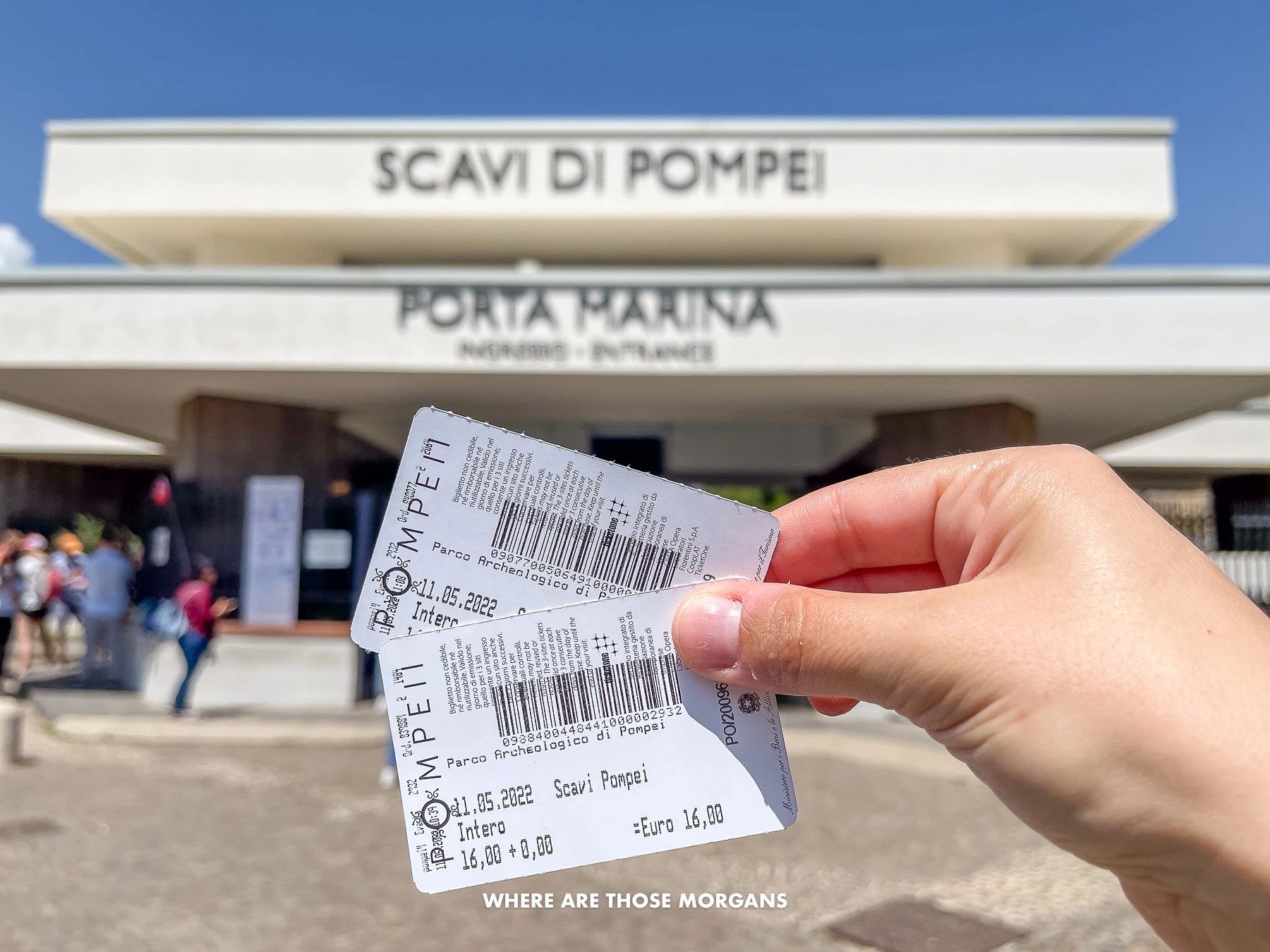 This was Kristen holding out our 2 entry tickets (it cost €16 back in 2022)
This was Kristen holding out our 2 entry tickets (it cost €16 back in 2022)
What’s the difference between Express and Plus tickets?
Express gives you entry to almost all areas of the ruins, but Plus gives you additional access to Villa dei Misteri, Villa di Diomede and Villa Regina (located externally outside of the ruins in nearby Boscoreale).
We did Express the first time and Plus the second time. It was worth paying a little bit extra for the Plus tickets just to see Villa dei Misteri and Villa di Diomede. We didn’t bother going to see Villa Regina because we didn’t have time, but this shuttle bus connects to Boscoreale.
Note: You can buy Express tickets and then purchase access to the villas separately at the Porta/Ercolano via della Tombe gate for €8. But it works out more expensive this way, so make sure you get the Plus tickets if you want to see the villas.
Pompeii entry ticket prices are as follows:
| Plus | Express |
|---|---|
| Daily tickets: 5,000 | Daily tickets: 15,000 |
| Full price: €23 | Full price: €19 |
| EU citizens aged 18-24: €3 | EU citizens aged 18-24: €3 |
| Under 18’s: Free | Under 18’s: Free |
Audio guides: The cost to rent audio guides in person is €9 for one, €14 for two (and then €7.50 for each audio guide afterwards). For children it’s €5 for one audio guide and €9 for two. Languages include English, German, French, Italian and Spanish.
Important: Entry to Pompeii archaeological site is free for all visitors on the first Sunday of every month. It’s always the busiest day of the month, so get in early if you want one of the 20,000 daily spots available.
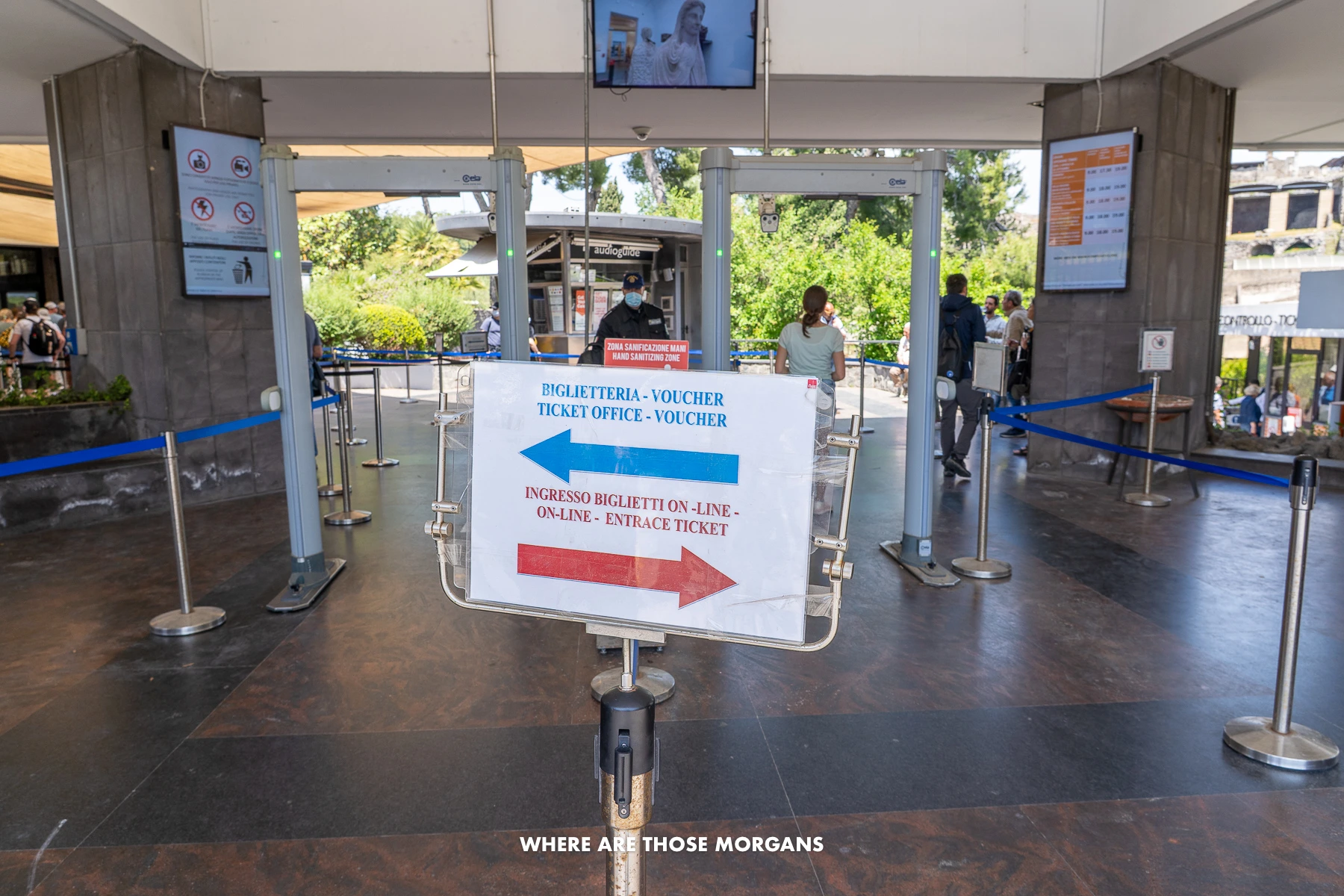 This was Kristen walking through the online ticket entrance as we arrived
This was Kristen walking through the online ticket entrance as we arrived
There is also a 3-day ticket you can buy that includes access to Pompeii (Plus ticket), Oplontis, Villa Arianna, Villa San Marco, Libero D’Orsi Museum, Boscoreale and shuttle for €26 per person.
This could be perfect if you’re super interested in the whole archaeological site and have plenty of time, but most people will be fine with just a Plus or Express ticket for one day.
Pompeii’s opening hours are as follows:
- 1st April to 31st October – 9:00am to 7:00pm (last entry 5:30pm)
- 1st November to 31st March – 9:00am to 5:00pm (last entry 3:30pm)
Note: There are three entrances to the ruins – Porta Marina, Piazza Anfiteatro, and Piazza Esedra. Porta Marina is the main entrance near Pompei Scavi train station, and it’s the only entrance we’ve used across two visits.
It’s easy to reach Pompeii’s main entrance from Naples, Ercolano, Torre del Greco and Sorrento by Circumvesuviana train red line.
Booking A Guided Tour
If you want a more complete experience from your visit to Pompeii, book a guided tour instead of just buying basic Express or Plus entry tickets.
Why would you pay more for a guided tour? Because you’ll learn so much more about what you’re looking at throughout the ruins than you would with just an audio guide.
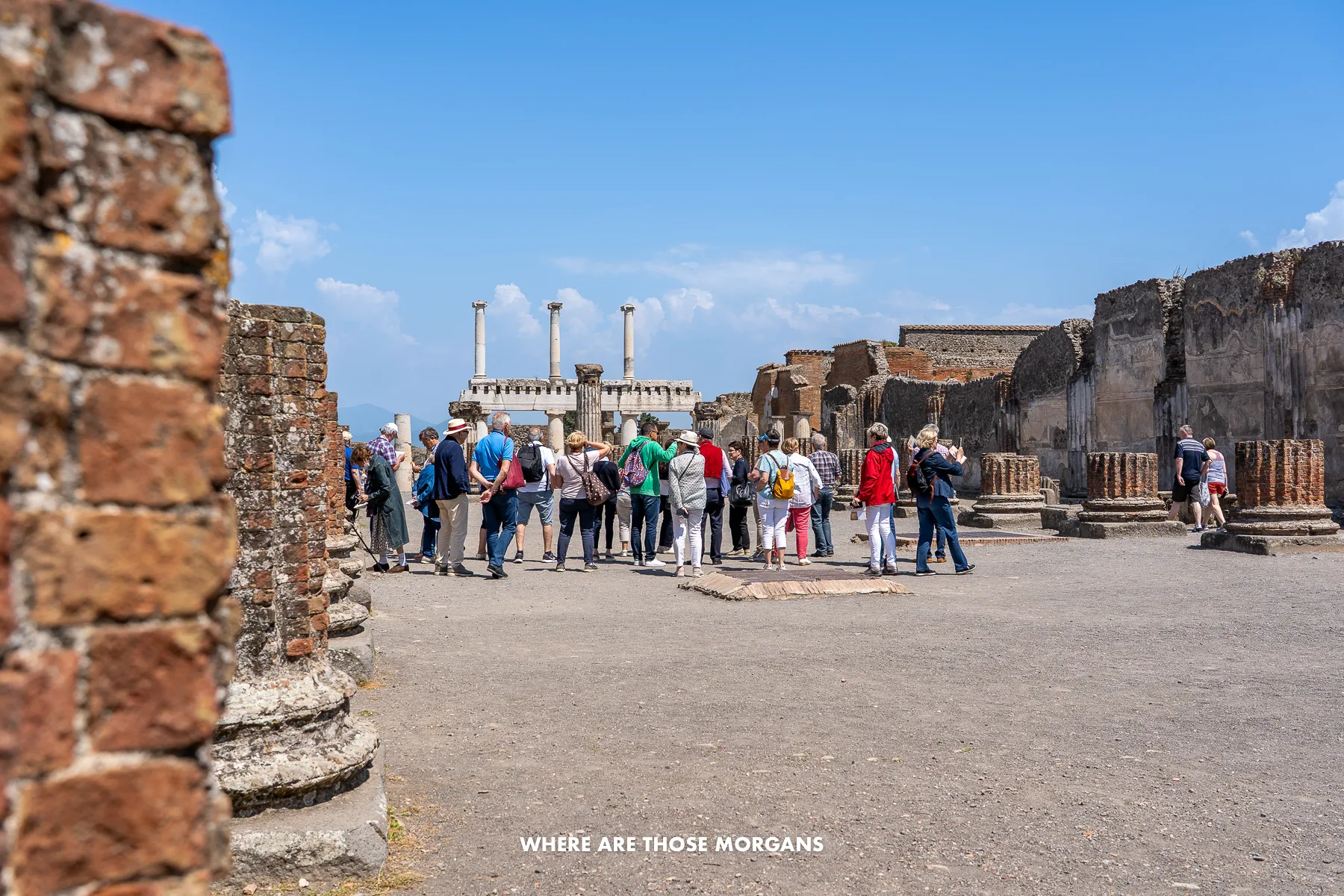 We saw this small group tour in the Basilica not long after entering
We saw this small group tour in the Basilica not long after entering
During our first visit we thought the audio guide was good, and it was the cheaper way to visit Pompeii, so we did the same thing for our second visit. But during that second visit with our audio guides we both agreed that we definitely should have booked a guided tour for a deeper dive into the remains.
We got fed up with having to figure out our own walking route around the ruins, hoping to stumble across something important and then listen to the information for that place. With a guided tour you don’t have to do any thinking about where to go next, you just follow your guide.
And the local guides running these tours don’t just offer more information than what’s on the audio guides, they also take you straight to the most important ruins and skip the less impressive areas. With our audio guides we had no idea about the order of importance of the houses or temples.
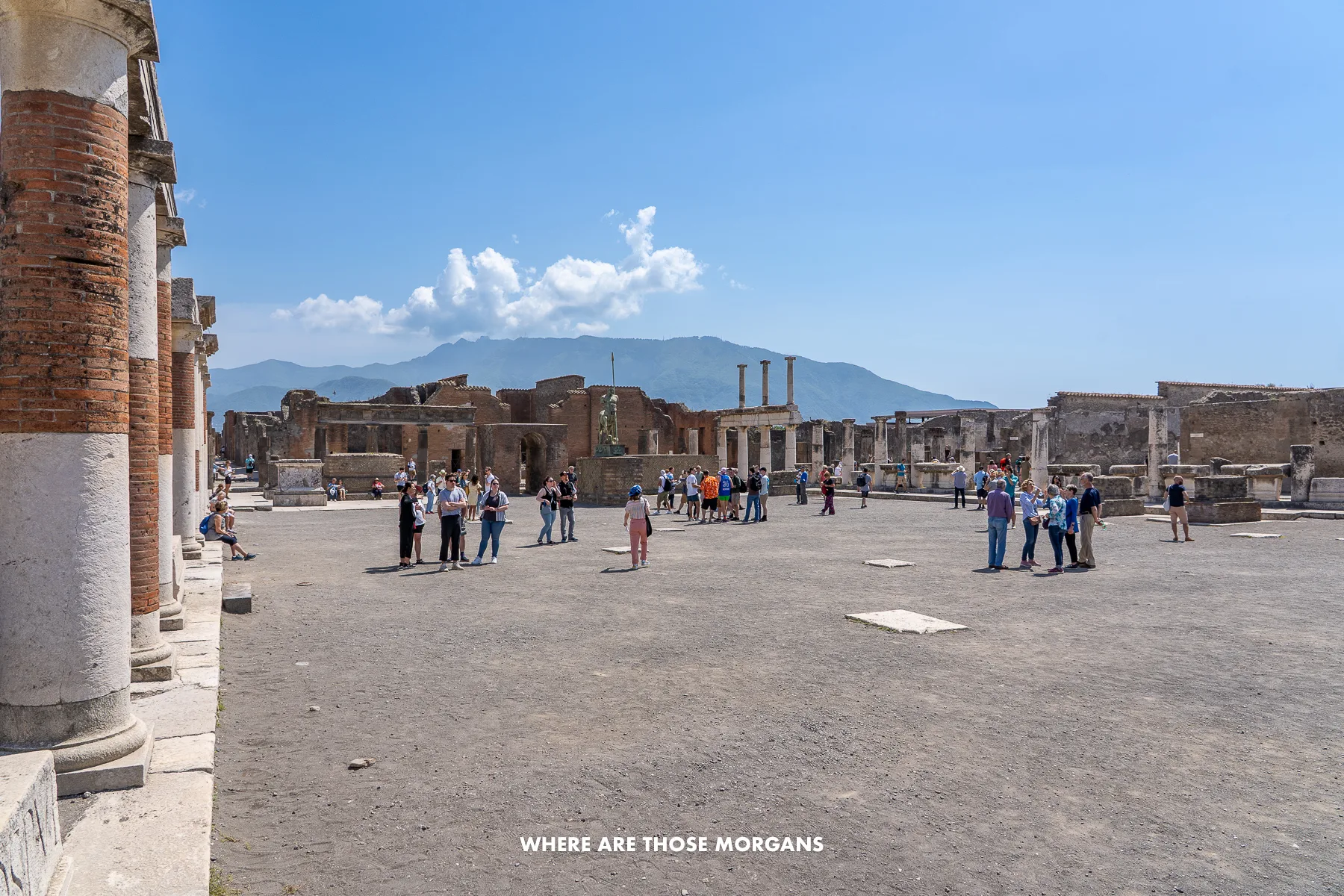 There were several clusters of groups on guided tours inside the Forum
There were several clusters of groups on guided tours inside the Forum
Pompeii is a massively popular tourist attraction, so there’s plenty of excellent guided tour options with sky high ratings from several operators.
Here are the best options available:
Official tour: You can request a guided tour at the main entrance between 9:00am-3:00pm. The service is provided by freelance guides and you’ll agree on a price, route and duration in person.
2 hours with Viator: This popular guided tour takes you to the most important spots in Pompeii. It doesn’t include entry tickets, but it’s a good one if you’re shorter on time.
Both ruins with Viator: This guided tour with an archaeologist takes you to Pompeii and Herculaneum. Entry tickets to each site included. This one is best if you want to see both ruins without having to deal with buying tickets.
Ruins and Vesuvius with Viator: Guided tour of Pompeii followed by transport to Vesuvius. Entry tickets to the ruins and crater included. This is a great option if you also want to do Vesuvius without all the faffing around with logistics like we did.
Horse riding with Viator: For a totally unique experience, take a look at this 7-hour guided tour of Pompeii followed by wine tasting lunch and guided horseback ride through Mt Vesuvius National Park.
3 hours with Walks of Italy: This top rated 3 hour tour of Pompeii includes skip the line entry tickets and professional archaeological guide. We think this is the best basic guided tour available.
From Rome with Walks of Italy: What if you want to do Pompeii from Rome? This 13 hour tour starts early in Rome, gets you to Pompeii as it opens with entry ticket and archaeologist tour guide, then goes to the Amalfi Coast with 2 hours free time in Positano.
We would happily book any of the tours listed above, and this is the same list of tour options we’d send to our friends and families. If pushed, we’d say book with Walks of Italy because we’ve always had the best experiences with them, especially in Italy where they specialize.
Mistakes To Avoid
Underestimating the size: At around 170 acres in size, it takes at least 3-4 hours to fully explore Pompeii. Make sure you have enough time available in your itinerary to see it all at a reasonable pace.
Not booking in advance: Lines at the ticket office can be over an hour long in peak months. And since late 2024, daily ticket numbers have been limited to 20,000 because of over-tourism in the summer. Book in advance to avoid disappointment, especially in July or August.
Thinking summer is best: July or August might sound like a good idea to visit Pompeii in principle, but trust us, it’s not. Our July trip was way worse than our May trip because it was too hot and too busy. Go in spring or fall instead.
Not thinking about the sun: The whole site is open and exposed with very little shade, so you need sunglasses, hats, sunscreen and plenty of water. Go first thing in the morning if you visit in summer.
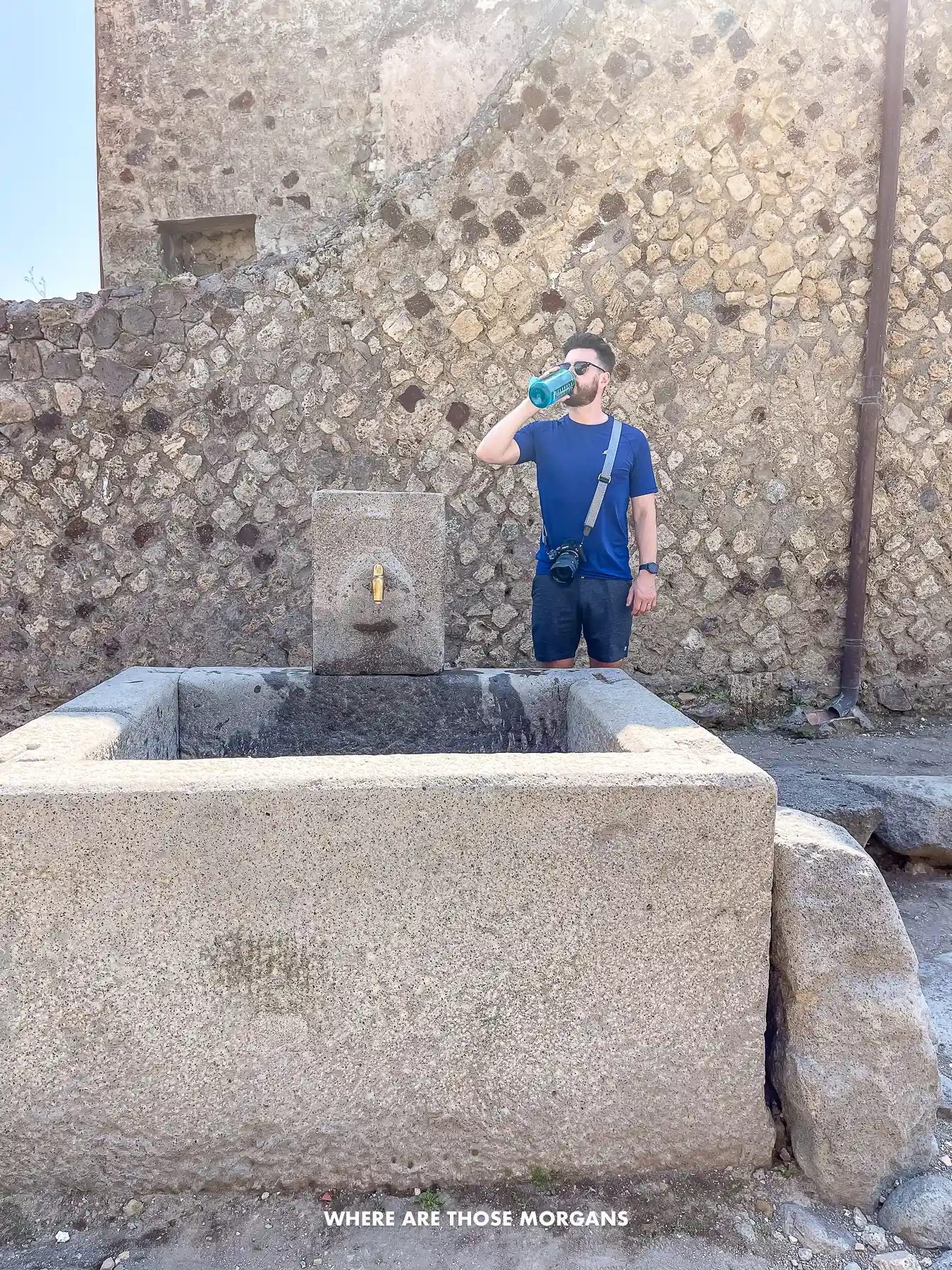 Here’s Mark drinking water from a tap inside the ruins
Here’s Mark drinking water from a tap inside the ruins
Wearing the wrong shoes: We walked well over 10,000 thousand steps both times we visited the ruins, and a lot of the ground is uneven. You must wear comfortable shoes otherwise you’ll end up having trouble with blisters or cuts.
Not eating before going: The food options nearby and inside are limited, overpriced and low quality. Make sure you eat a good breakfast or lunch before entering. And take snacks so you don’t get hangry half way around!
Forgetting your ID: If you qualify for free entry as an under 18 or discounted entry as an EU citizen aged 18-24, you must present ID as proof of your age. Without it, you’ll have to pay full entry price.
Being disrespectful of the site: Climbing on structures or touching frescoes on the walls damages the 2,000 year old artifacts and contributes to the decline of the site. Pay attention to signs and barriers, they’re in place for a reason.
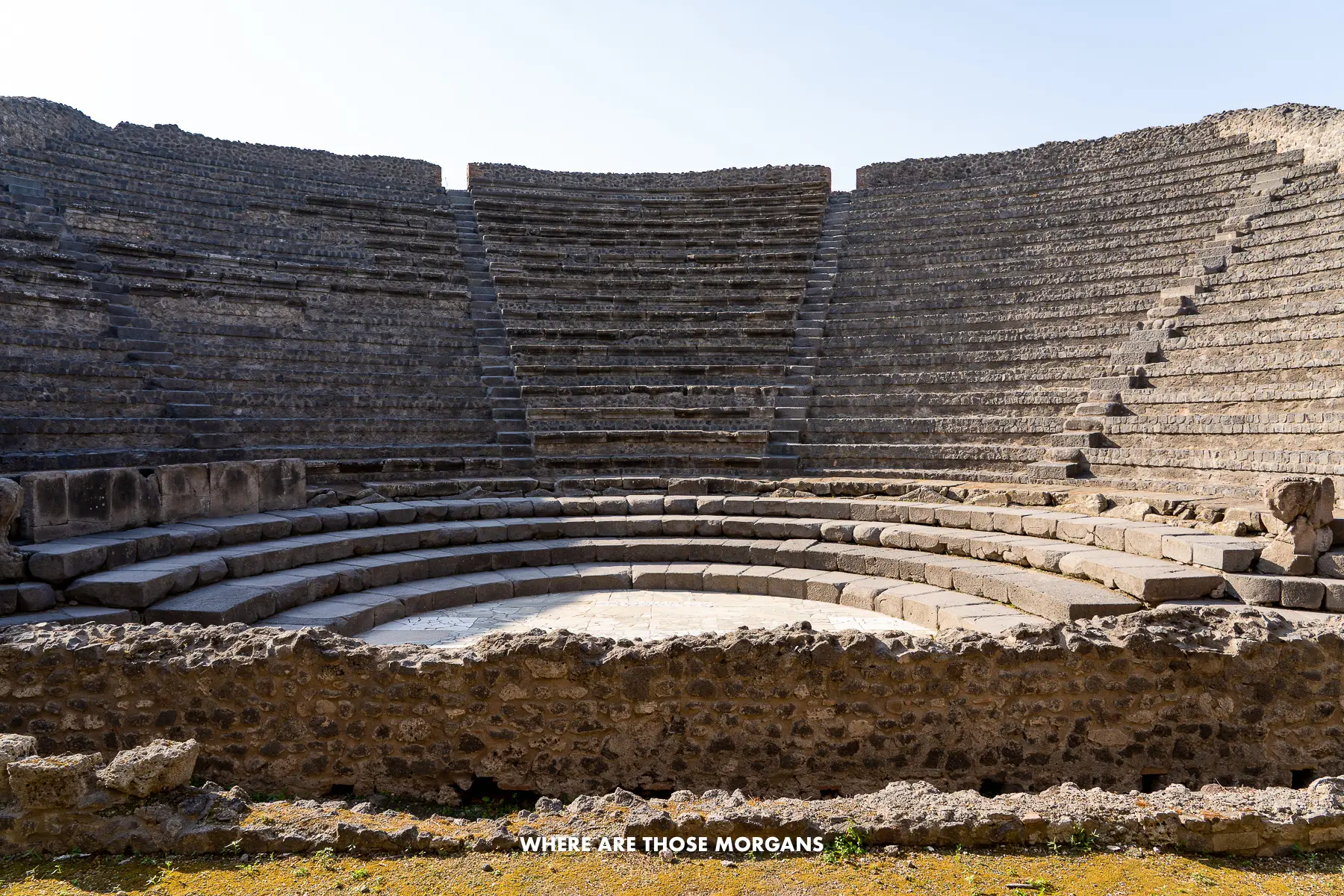 Teatro Piccolo was one of our favorite photo spots inside the ruins
Teatro Piccolo was one of our favorite photo spots inside the ruins
Not knowing about the museum in Naples: Most of Pompeii’s best-kept mosaics, frescoes and treasures are now located inside Naples Archaeological Museum. Don’t go to Pompeii expecting to see all of its most famous artifacts in place. Instead plan to visit both sites.
Not doing a tour: If you don’t at least do the self guided audio tour you’ll walk around looking at rocks and then leave without knowing anything new. At a minimum, pay for the audio guide. Better yet, pay for a guided tour with a professional.
Missing the victim casts: We found the plaster casts of people killed by the eruption to be upsetting but moving and crucial to the overall experience. They’re not easy to find, so make sure you walk far and wide to see them.
Not taking a break: It’s so easy to get archaeological fatigue in Pompeii. You’re looking at rocks, ruins and columns for hours and it all starts to blend together. Take a short break, sit down and go back refreshed.
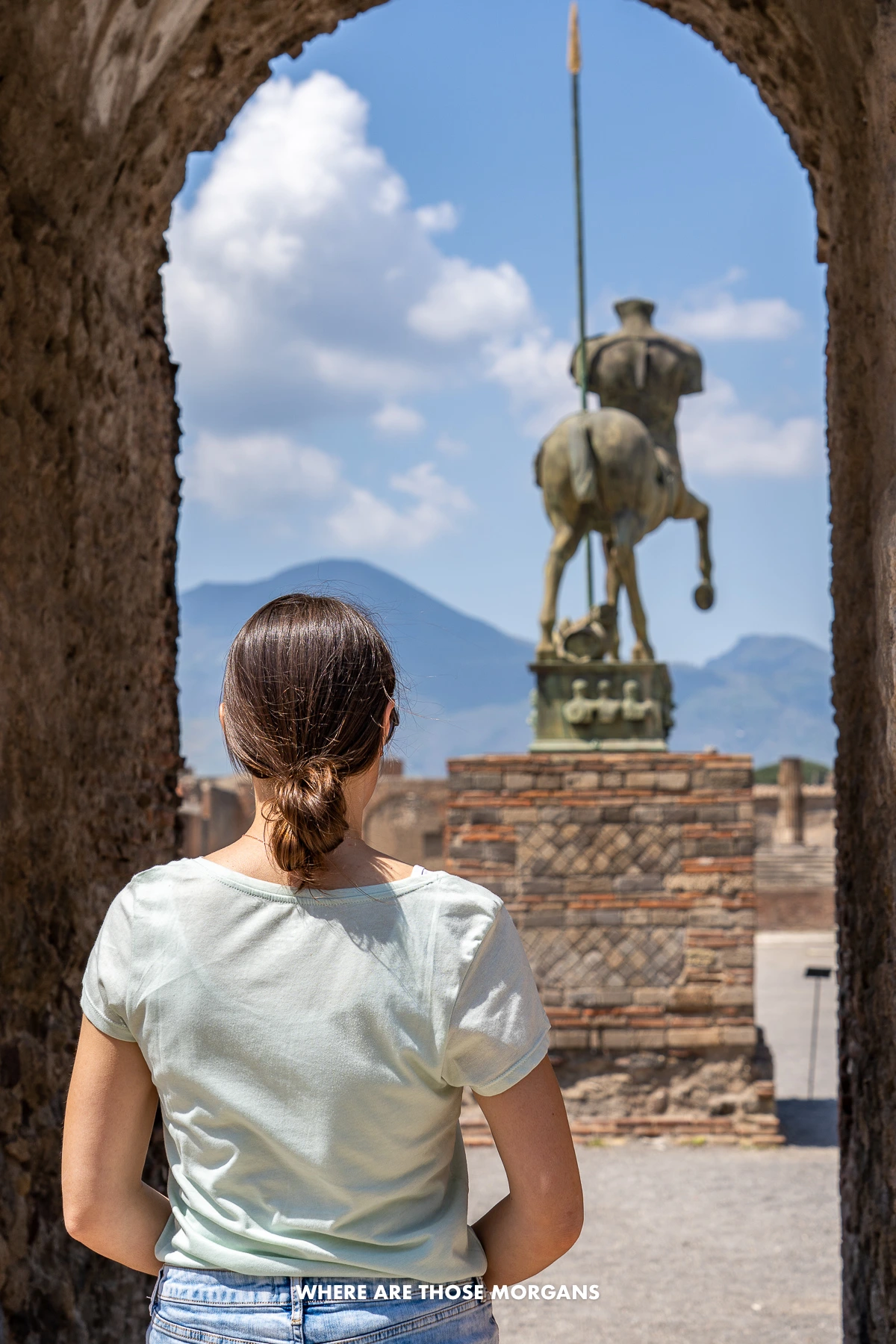 Here’s Kristen looking through an arch at a statue and Vesuvius
Here’s Kristen looking through an arch at a statue and Vesuvius
Taking too many photos: We were guilty of this during our second trip because we wanted to get the photos we needed for this guide. And we ended up not taking in the actual ruins as much as we wanted. Don’t spend your whole time inside taking photos.
Skipping the amphitheater: The amphitheater is at the far side from the main entrance so people often skip it, but that’s a mistake. It’s well worth seeing and it’s usually quieter.
Following the crowds: If you see a big group of people, don’t follow them thinking you’re missing something. Instead, go the other way to find quieter streets and ruins to really soak up the eeriness.
Forgetting this was a catastrophe: Pompeii isn’t an Instagram shoot. This is a place where 2,000 people died horrifically.
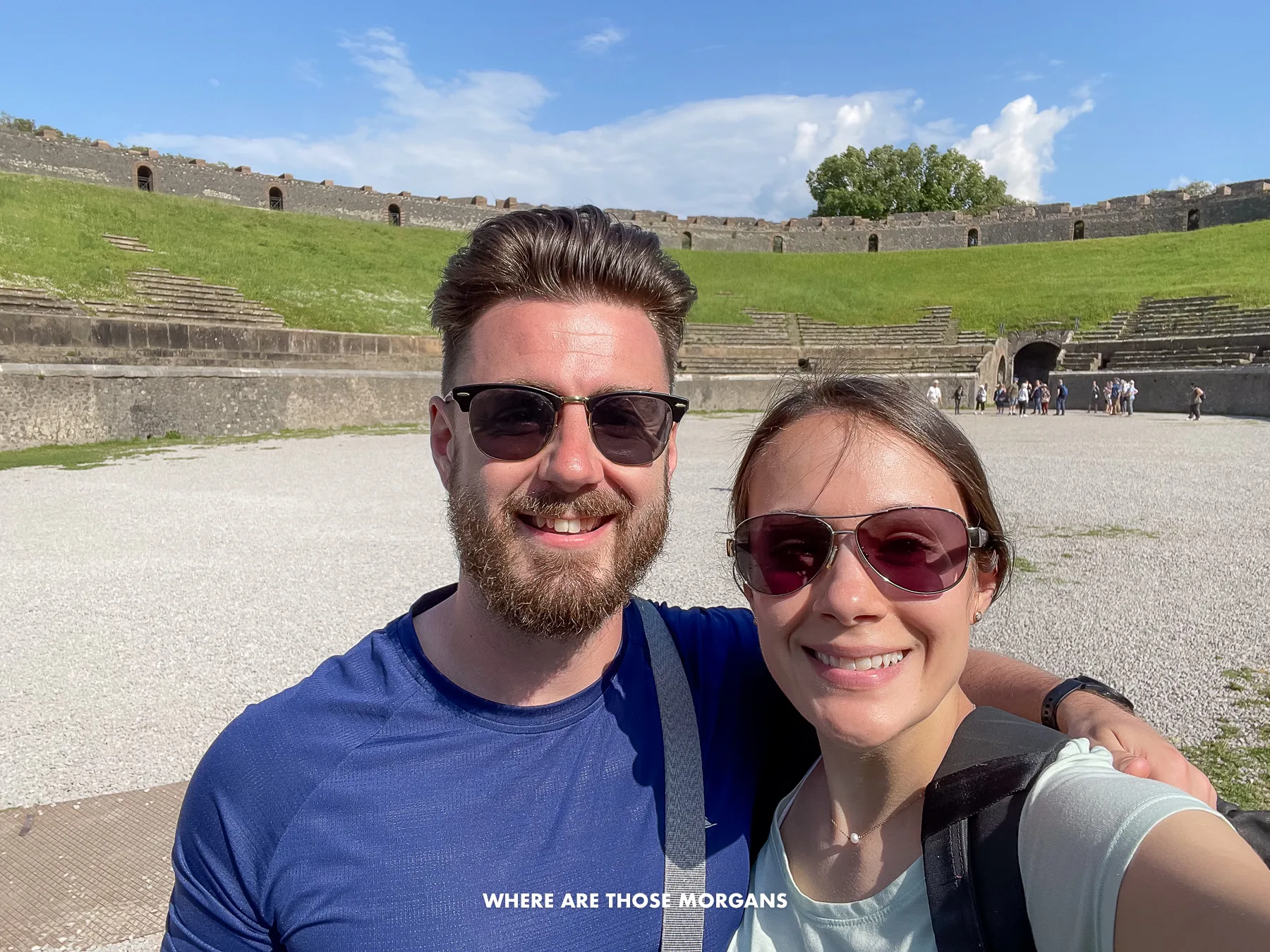 We took this selfie in Pompeii Amphitheater after walking for hours in sweltering heat!
We took this selfie in Pompeii Amphitheater after walking for hours in sweltering heat!
Our Pros + Cons
What we loved :
- Totally unique experience
- Affordable entry cost
- Easy to reach by train
- Excellent guided tour options
- Huge site to explore
- Incredibly immersive
What we didn’t like :
- No escape from elements
- Heavy crowds
- Physically demanding
- Can feel overwhelming
- Confusing ticket purchasing
- Terrible food options
Pompeii Walking Route Map
If you end up doing Pompeii by yourself without a guided tour, make sure you pay to rent audio guides and follow the walking route we’ve created in the map below.
Map key:
- Red – Area 1: The Forum
- Blue – Area 2: Theater District
- Yellow – Area 3: Eastern Pompeii
- Purple – Area 4: Northern Pompeii
- Black – Area 5: Villas (Plus tickets only)
How to use this map: Click the map above to activate and click the arrow icon in the top left to see our list of sites to visit (in the exact order they appear). You can also see a full version of the map by clicking the “view larger map” icon in the top right. When you’re in Pompeii you can open this map, tap the next place you want to visit and get live directions.
How to save this map: Click the small star next to the map title – that will add the map to your Google account. Open your Google Maps app, tap “saved”, then tap “maps” and open this map.
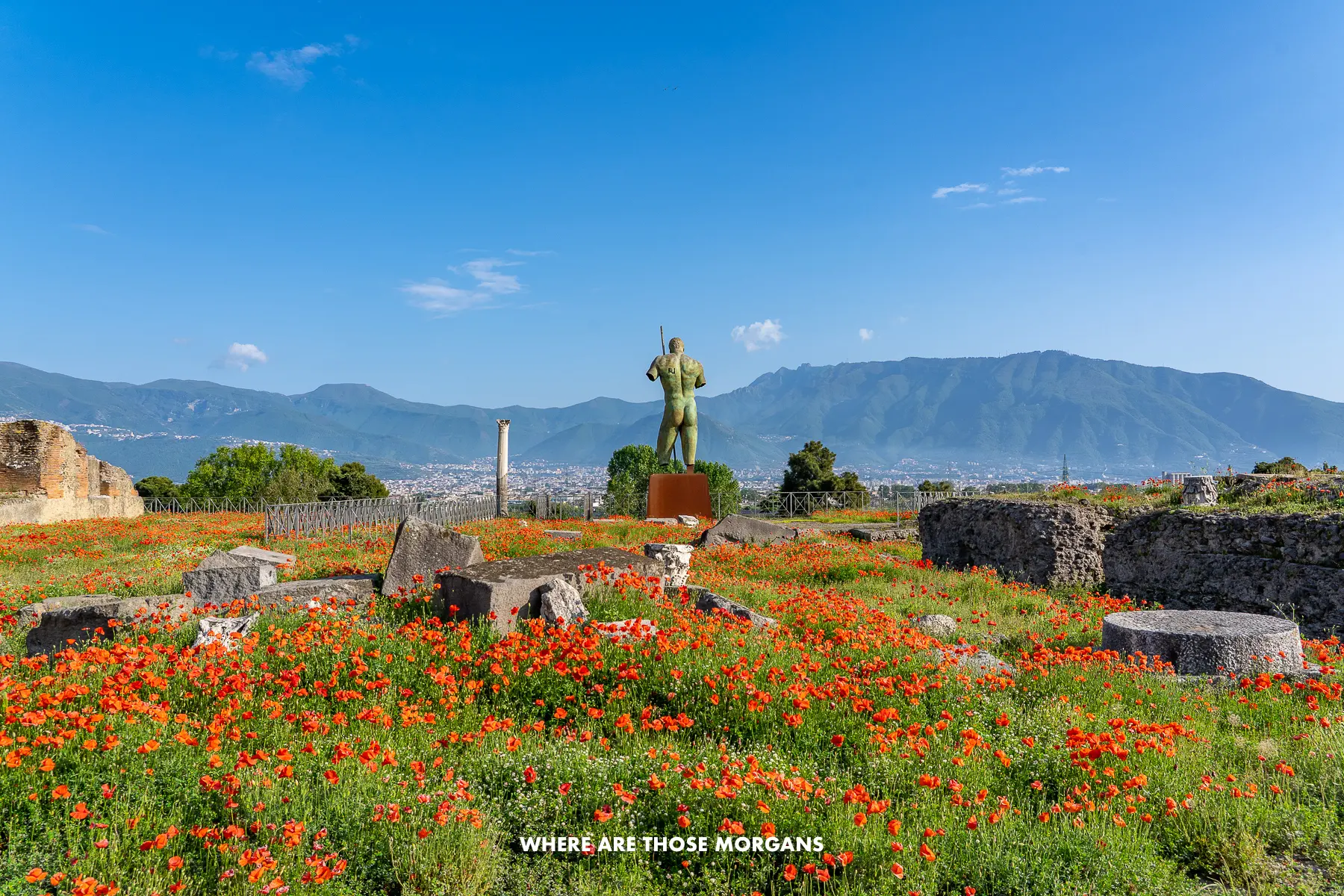 We took this photo near the end of our second visit at the Temple of Venus
We took this photo near the end of our second visit at the Temple of Venus
Is Pompeii Really Worth It?
Yes, Pompeii is 100% worth visiting. It’s not only one of the world’s most important archaeological sites, but it’s also remarkably well-preserved and maintained, and thankfully it avoids the commercialized tourist-trap feel that we’ve experienced at many other famous sites around the world.
We love how easy it is to visit Pompeii by train from Naples or Sorrento, and how many fantastic guided tour options are available. The entry costs have gone up in recent years, but we still think €50 for a couple to explore the ruins with an audio guide each is reasonable for such an iconic ancient site.
Herculaneum was smaller and better-preserved but it didn’t have that same mind-blowing scale or immersion as Pompeii, which is what really knocked the socks off us both times we visited.
We travel the world for a living and always approach things like this from a neutral standpoint to help our readers make more informed decisions without bias. But this is still our opinion, so don’t just take our word for it.
Before booking anything or even planning Pompeii into your itinerary, we encourage you to read the latest comments on Google Reviews and on Tripadvisor. You’ll be able to get a bigger picture about what to expect based on other people’s recent experiences.
Next Steps
We hope our Pompeii guide helps with planning your visit to Italy.
If you’d like expert help planning your trip to Pompeii, the Amalfi Coast or even a wider Italy trip – book a call with us and we’ll walk step-by-step through your itinerary or answer any questions you have.
Still figuring out your plans for Italy?
Finally, if you’ll be visiting more places on the same trip, we recommend reading our Italy travel planning guide for helpful tips and advice.
Happy Travels,
Mark and Kristen
Find our guide helpful? Pin it for later!
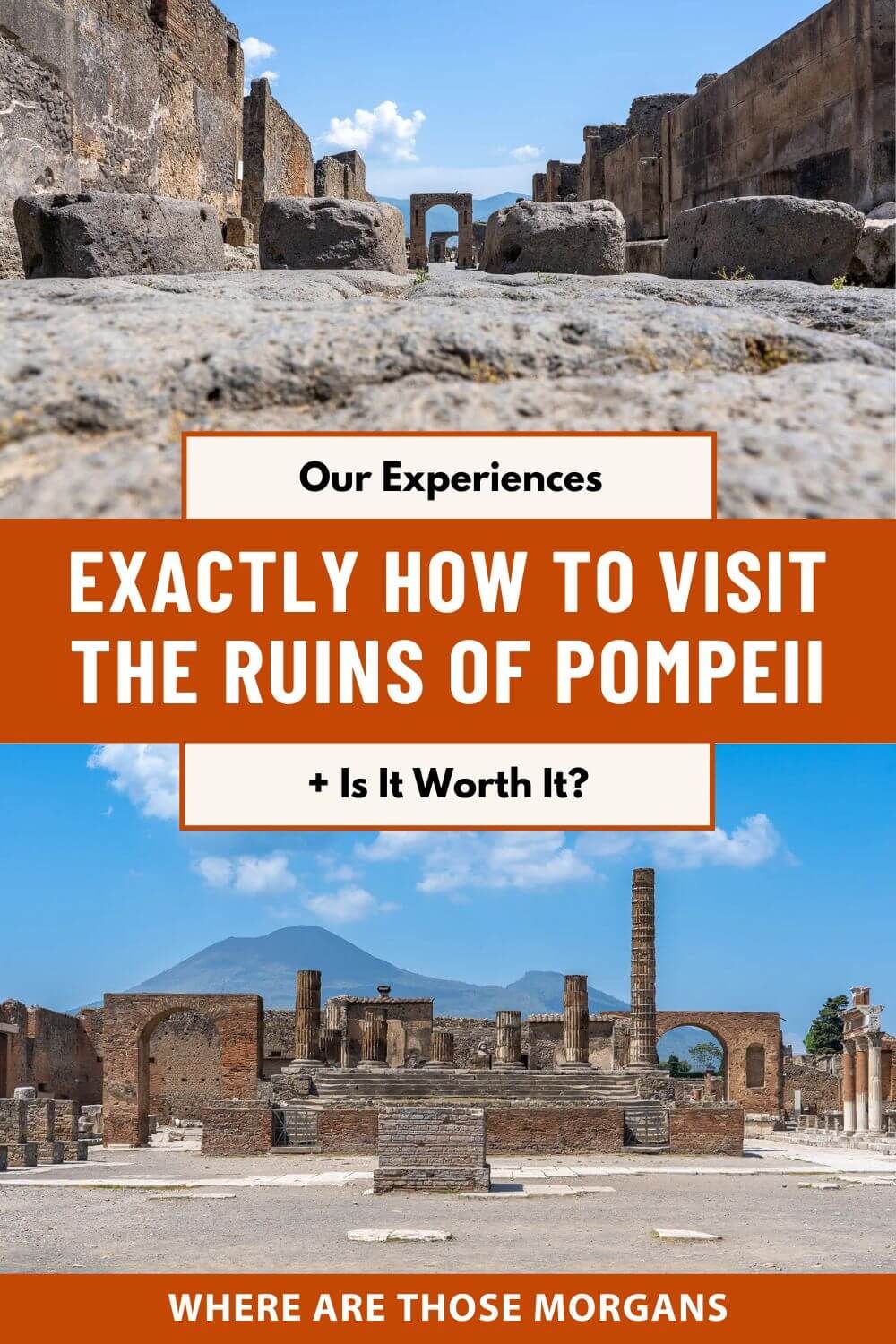
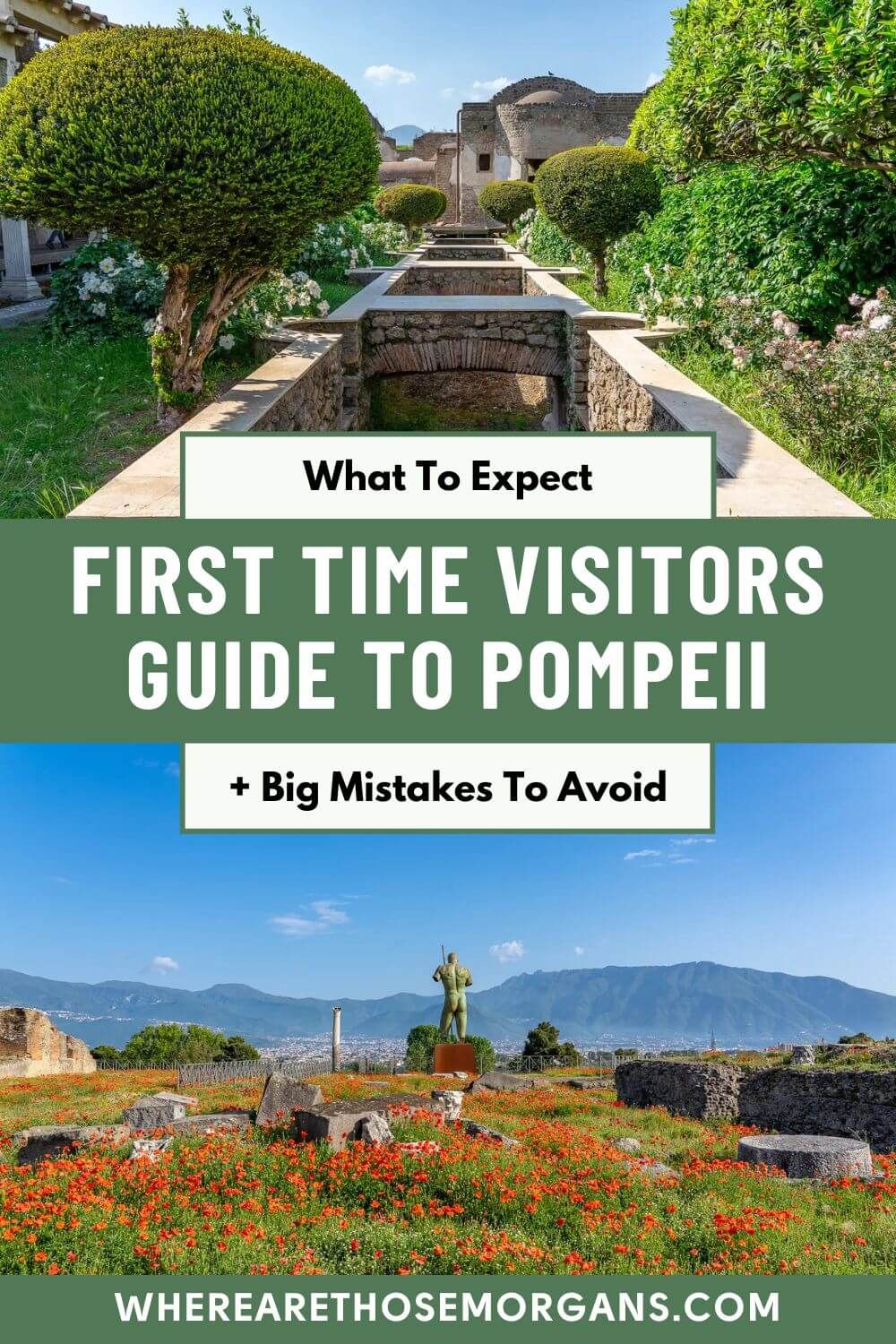
All Rights Reserved © Where Are Those Morgans, LLC. Republishing this article and/or any of its contents (text, photography, maps, graphics, etc.) in whole or in part is strictly prohibited.
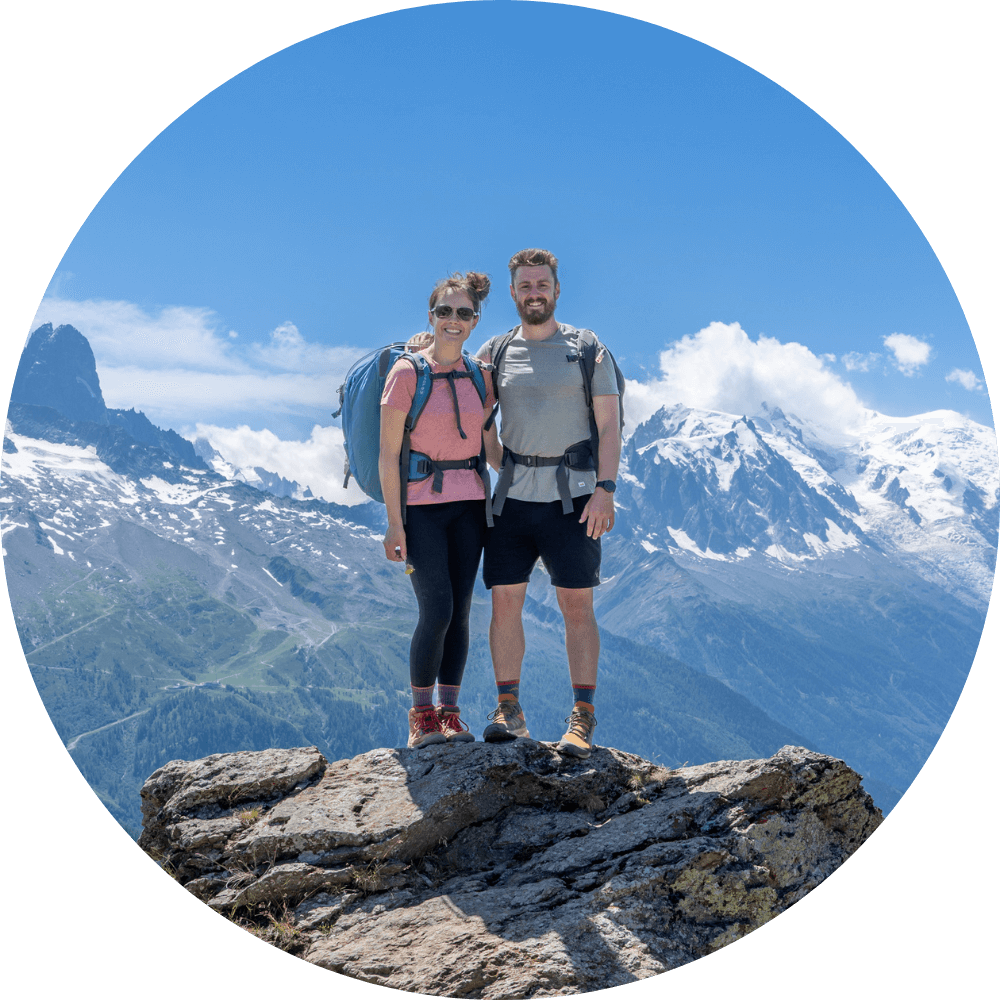
Mark and Kristen spent 6 years traveling the world, visiting over 40 countries across 4 continents and more than 30 US states. They created Where Are Those Morgans in 2018 to help others plan the best possible vacations by writing authentic travel and hiking guides based on their real experiences.
Since the arrival of baby Maya in late 2024, Mark and Kristen’s extensive travels have slowed down but they still take plenty of trips. Where Are Those Morgans now helps millions of travelers each year to visit new places and hike new trails through information-packed blog posts and expert travel guidebooks. Read more about Mark and Kristen.
